Nox Medical ASDB1 Medical Device - A Patient Worn Digital Sleep Recording Device User Manual Nox SDB Device User Manual
Nox Medical Medical Device - A Patient Worn Digital Sleep Recording Device Nox SDB Device User Manual
User Manual

U
Us
se
er
r
I
In
ns
st
tr
ru
uc
ct
ti
io
on
n
N
NO
OX
X
T
T3
3

Nox T3 - User Instruction
Version 0.102
Latest Revision 21 April 2008
Copyright© 2008
Nox Medical - All rights reserved
Nox Medical ehf
Keldnaholti
IS - 112 Reykjavík
Iceland
Phone: +354 - 5229000
Fax: +354 - 5229111
Website: www.noxmedical.com
Email: support@noxmedical.com
Copyright Notice
No part of this publication may be reproduced, transmitted, transcribed, stored in a retrieval system, or
translated into any language or computer language, in any form, or by any means: electronic,
mechanical, magnetic, optical, chemical, manual, or otherwise, without the prior written authorization
from Nox Medical.
Disclaimer
This document may contain typographical errors or technical inaccuracies. Nox Medical does not accept
any liability for the use or misuse whether direct or indirect of the products, or for damages arising out
of the use of or inability to use the products. Users must accept all responsibility for any results obtained
by or concluded from data obtained by the products including software from Nox Medical. All clinical
conclusions and decisions that are based on the use of this product are the responsibility of the user.
Warranty
Nox Medical warrants the products to be free of defects in materials and workmanship for a certain
period of time from the date purchased. The sole liability of Nox Medical is limited to replacement or
repair of the product at the option of Nox Medical if any part is proven to be defective in workmanship,
performance, or materials during the warranty period. Under no circumstances shall Nox be liable for
any loss of revenues or damage, direct, consequential, or incidental, including loss of profit, property
damage, or personal injury arising from the use of, or the inability to use this product. This warranty is
intended for the original buyer and is in lieu of all other warranties or previous agreements, expressed or
implied. This warranty is rendered void if the product is used for other than its intended purpose or is
subject to abuse, misuse, tampering, neglect or unauthorized modifications.
Contents
Contents .................................................................................................................................................................... 3
Introduction ................................................................................................................................................................ 4
Regulatory Information .............................................................................................................................................. 5
Intended Use ......................................................................................................................................................... 5
Warnings and Cautions for Use ............................................................................................................................ 5
Guide to Symbols .................................................................................................................................................. 5
System Components ................................................................................................................................................... 7
The Nox T3 Device ............................................................................................................................................... 7
Interfaces ......................................................................................................................................................... 7
Starting/Stopping a Recording ......................................................................................................................... 8
Navigating the Nox T3 device ......................................................................................................................... 8
Power ............................................................................................................................................................... 9
The Nox T3 Application Software – Noxturnal .................................................................................................. 10
Respiratory Effort Sensor (Belt).......................................................................................................................... 10
Abdomen –Thorax Cable .................................................................................................................................... 10
USB Cable .......................................................................................................................................................... 11
Nasal Cannula ..................................................................................................................................................... 11
Clip Strap ............................................................................................................................................................ 11
Carry Bag ............................................................................................................................................................ 11
Pulse Oximeter .................................................................................................................................................... 12
Inserting Batteries .......................................................................................................................................... 12
Oximeter Sensors ........................................................................................................................................... 12
ExG Sensors ........................................................................................................................................................ 13
Nox Noxturnal .......................................................................................................................................................... 14
System Requirements .......................................................................................................................................... 14
Desktop Minimum System Requirements ...................................................................................................... 14
Laptop Minimum System Requirements........................................................................................................ 14
Desktop Recommended System Requirements .............................................................................................. 14
Laptop Recommended System Requirements ................................................................................................ 14
Installation........................................................................................................................................................... 15
Running the software .......................................................................................................................................... 18
Configuring the Device .................................................................................................................................. 19
Viewing Recorded Data ................................................................................................................................. 21
Hook-Up ................................................................................................................................................................... 23
Attaching the Device and the Respiratory Effort Sensors ................................................................................... 23
Recording of Respiratory Sounds and Snoring ................................................................................................... 25
Applying the Nasal Cannula ............................................................................................................................... 25
Attaching Electrodes ........................................................................................................................................... 25
Pulse Oximeter Module....................................................................................................................................... 26
Choosing the Appropriate Pulse Oximerer Sensor ......................................................................................... 26
Attaching the Pulse Oximeter Module and Sensor......................................................................................... 26
Precautions for Use of the Pulse Oximeter .................................................................................................... 27
System Maintenance................................................................................................................................................. 28
Calibration........................................................................................................................................................... 28
Cleaning .............................................................................................................................................................. 28
Disposal .............................................................................................................................................................. 28
Specification ............................................................................................................................................................. 29
Nox T3 Device .................................................................................................................................................... 29
Respiratory Effort Sensor .................................................................................................................................... 29
Nasal Cannula ..................................................................................................................................................... 30
Pulse Oximeter Module....................................................................................................................................... 30
Classifications ..................................................................................................................................................... 31
Certifications ....................................................................................................................................................... 31
EMC – Information ............................................................................................................................................. 32
Declaration of Conformity with USA Federal Communications Commission (FCC) and Canadian Ministry
of Health Rules for Electromagnetic Compatibility ....................................................................................... 32
Guidance and Manufacturer’s Declaration – Electromagnetic Emissions ..................................................... 34
Guidance and Manufacturer’s Declaration – Electromagnetic Immunity ...................................................... 34
Recommended Separation Distance between Portable and Mobile RF Communications Equipment and the
Nox T3 Device ............................................................................................................................................... 35
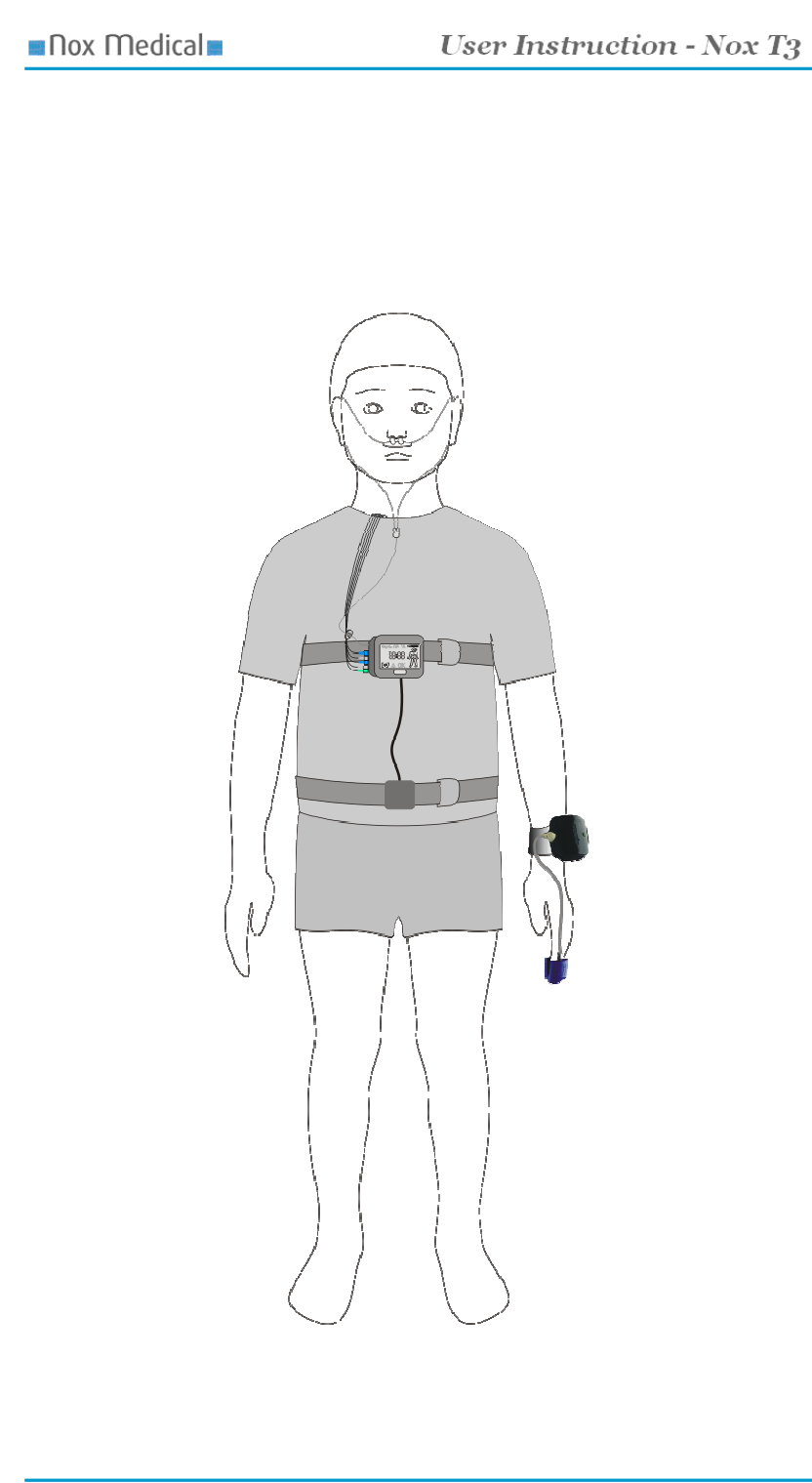
Introduction ● 4
Introduction
The Nox T3 system consist of a compact digital recorder that is worn by the patient, along with two
respiratory effort sensors, carry bag, clip straps, USB cable and the Nox T3 application (Noxturnal)
used for analyzing and reviewing of data. The device is able of recording signals from two respiratory
effort sensors, respiratory sound/snoring, nasal/mask pressure, pulse oximeter data, position/activity
data, and two channels of EEG/EOG/EMG/ECG leads.
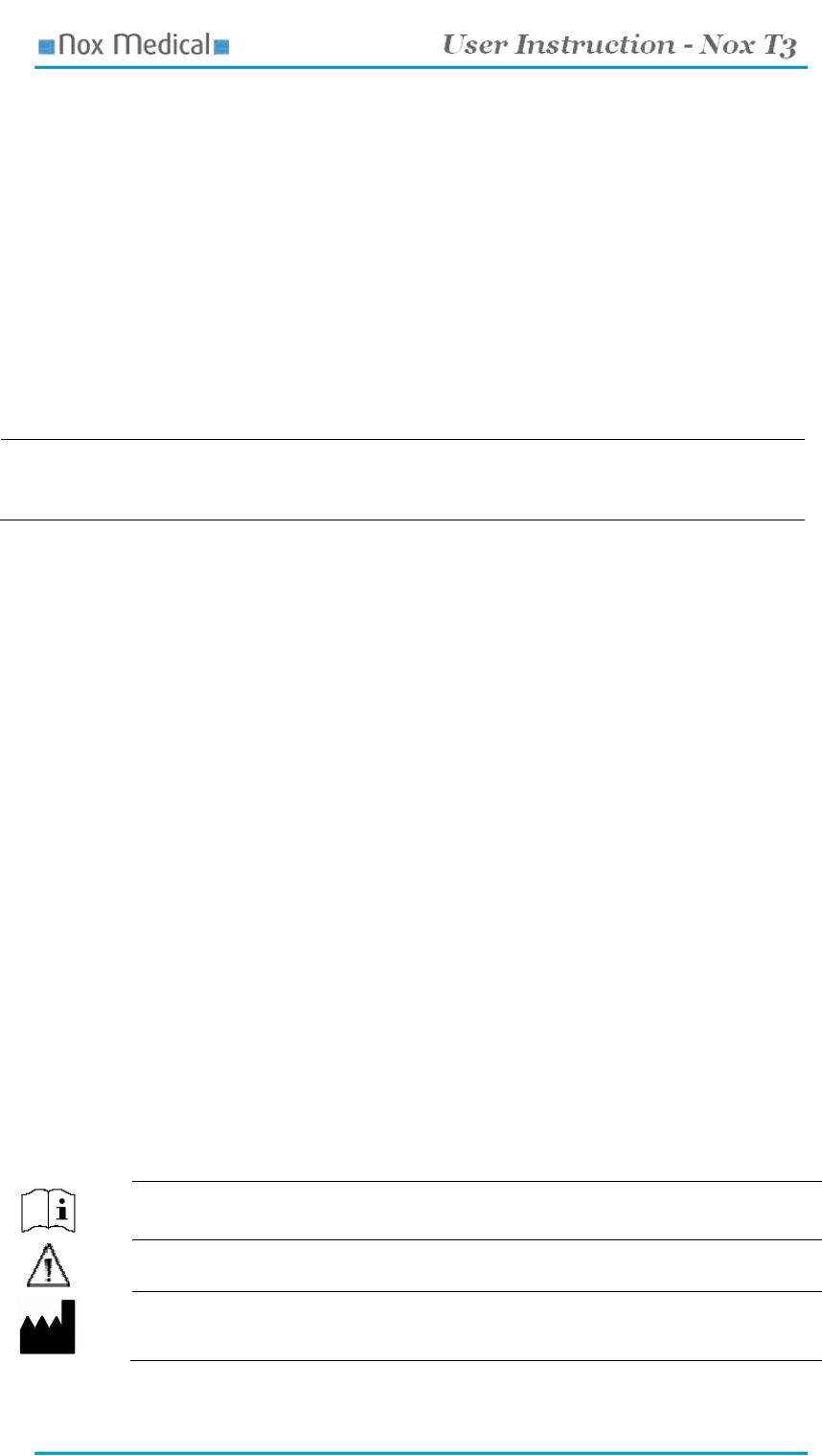
Regulatory Information
● 5
Regulatory Information
Intended Use
The Nox T3 device is intended for ambulatory recording of physiological signals during sleep. The
recorded signals are then downloaded to a PC where the signals can be viewed and analyzed by use of
the Nox T3 application.
The Nox T3 system can be used with both children and adults.
The Nox T3 system is NOT intended for any patient monitoring or automatic diagnosis.
The intended environments are hospitals, institutions, sleep centers, sleep clinics, or other test
environments, including patient’s home.
!
► Please read this manual carefully before use, especially sections marked with an
exclamation mark.
Warnings and Cautions for Use
► The device is NOT CERTIFIED TO BE USED FOR CONTINUOUS MONITORING where
failure to operate can cause injuries or death of the patient. The term CONTINUOUS
MONITORING is specified in the standard IEC60601-1.
► This system is intended only as an adjunct in patient assessment. It must be used in conjunction
with other methods of assessing clinical signs and symptoms.
► Caution: U.S. Federal law restricts this device to sale by, or on the order of, a physician.
► This system complies with international standards IEC60601-1-2 for electromagnetic compatibility
for medical electrical equipment and/or systems. This standard is designed to provide reasonable
protection against harmful interference in a typical medical installation. However, because of the
proliferation of radio-frequency transmitting equipment and other sources of electrical noise in
healthcare and other environments, it is possible that high levels of interference due to close proximity
or strength of source might disrupt the device’s performance. Medical electrical equipment needs
special precautions regarding EMC, and all equipment must be installed and put into service according
to information detailed in the EMC Information section of this manual.
► The device is classified as ordinary equipment regarding ingress of liquids, that is, it is not drip-
proof, splash-proof or watertight. During use of the device avoid all unnecessary contact with
moisture.
► The device is not defibrillator proof.
► Do not use any part of the system in an MRI (Magnetic Resonance Imaging) environment.
► The device and its accessories should be removed from the patient before download of data.
► No user serviceable parts inside the device. Serviced by authorized parties only. Warranty void if
opened.
Guide to Symbols
► Consult instructions for use.
►Caution, consult accompanying documents.
► Manufacturer.
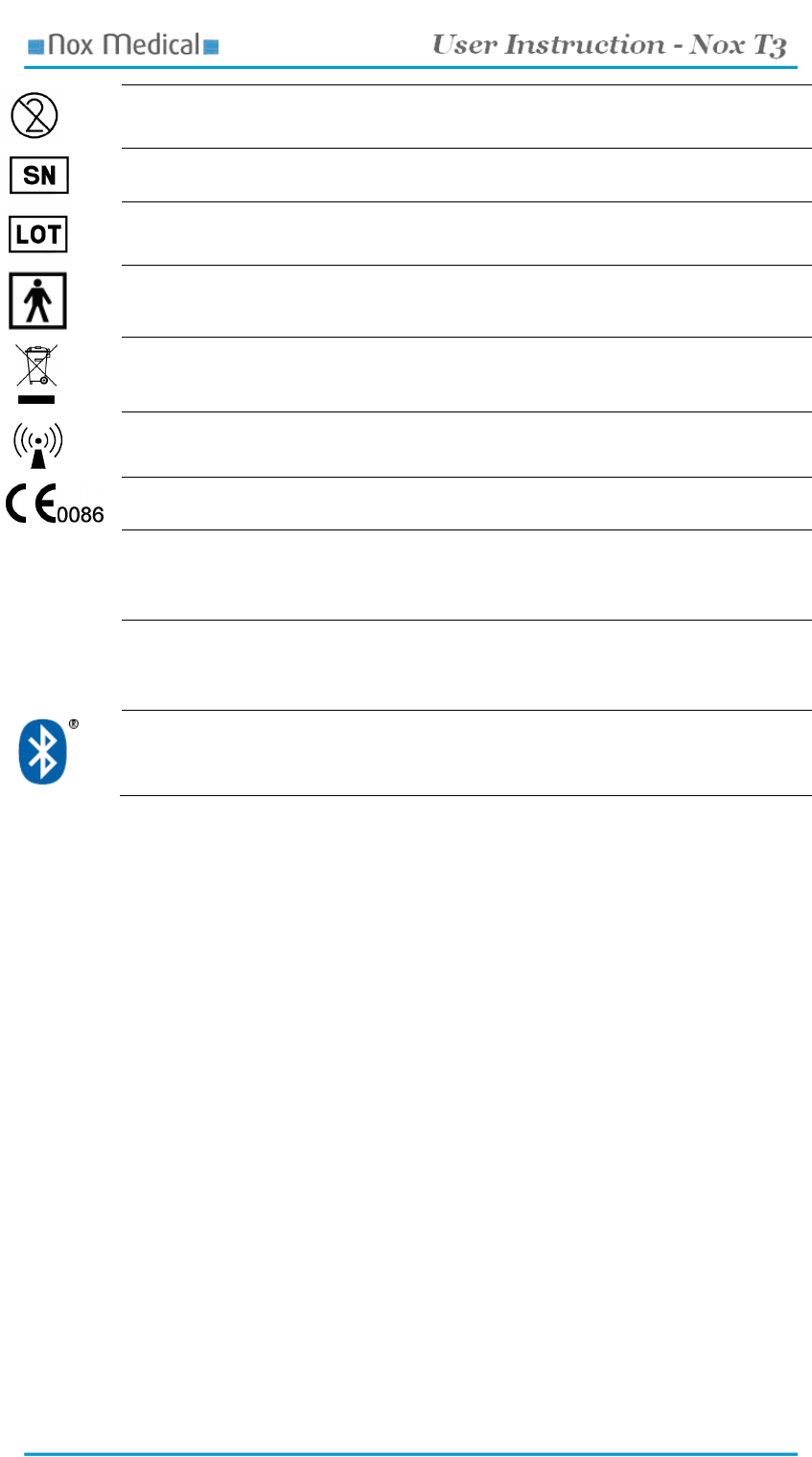
Regulatory Information
● 6
► Do not reuse
► Serial number.
► Batch code.
► Type BF applied part (patient isolation from electrical shock).
► In compliance with the European Directive on Waste of Electrical and Electronic
Equipment (WEEE) 2002/96/EC, do not dispose of this product as unsorted
municipal waste.
► Non ionizing electromagnetic radiation. Equipment includes RF transmitter:
interference may occur in the vicinity of equipment marked with this symbol.
► CE marking indicating conformance to EC directive No. 93/42/EEC concerning
medical device
FCC ID:
V5ANOX-T3-
0100
► FCC ID label.
Contains TX
IC: 1520A-
LMX9838
► Industry Canada (IC) label.
►Bluetooth® wireless technology
Bluetooth® Wireless Technology
The Nox T3 uses Bluetooth® wireless technology to receive signals from the Nonin Pulse Oximeter.
The Bluetooth® wireless technology is based on a radio link that offers fast and reliable transmission
of data. Bluetooth® radio uses globally available frequency range in the ISM band, intended to ensure
communication compatibility worldwide and a fast acknowledgement and frequency-hopping scheme
to make the link robust, even in noisy radio environments. Please refer to the Specification section for
details on RF specifications for Nox T3 and Nonin Pulse Oximeter.
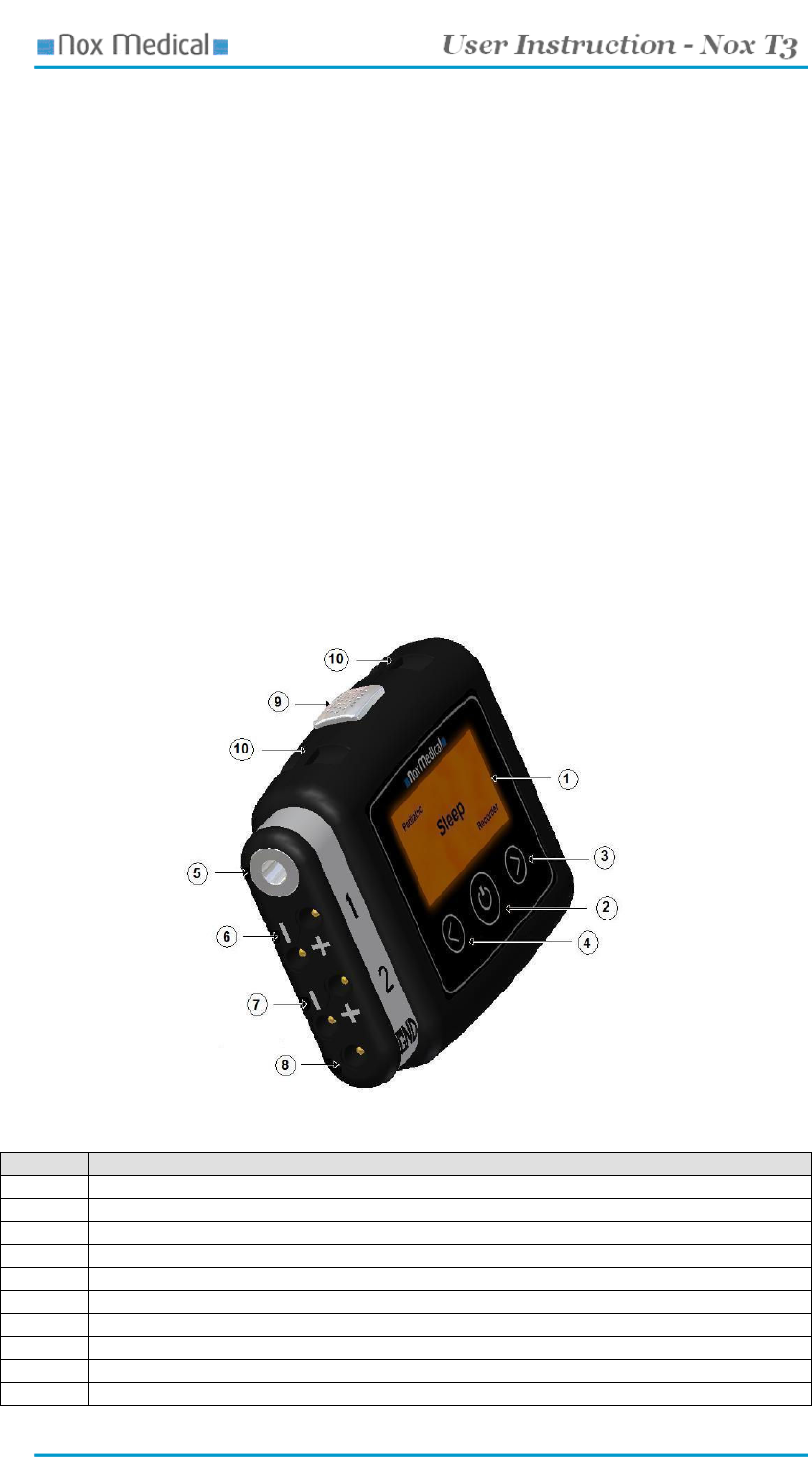
System Components
● 7
System Components
The Nox T3 Device
The Nox T3 device records signals from five external sensors and three built-in sensors. The external
sensors that can be used with the device are abdominal and thoracic respiratory effort sensors,
oximeter, and two leads of the following: ECG, EMG, EEG or EOG. The built-in sensors include a
pressure transducer allowing either recording of nasal pressure or mask pressure, a three dimensional
acceleration sensor for measure of patient’s position and activity, and a microphone for measuring of
snoring and true audio recording capabilities. The arrangement of sensors will be determined by the
type of study being performed. The device is worn on the patient’s chest by snapping it to the thoracic
respiratory sensor and securing its position with the clip straps. The device is powered with one AA
battery. The device has a display for status indication, signal integrity and preliminary results, and
buttons for control and event marking.
Interfaces
The Nox T3 device interface consists of a display, buttons, sensor inputs/connections and a USB
connector. The USB connector is placed under the locked battery lid making it inaccessible and tamper
prove for children, and connects to the USB cable for device configuration and data download. See the
figures and tables below for detailed description.
Number Function
1 Display
2 Push button – Select – used to start/stop recording and select display options
3 Push button – Forward button - navigate to the next page
4 Push button – Backward button - navigate to the previous page
5 Pressure lock - Connects to external nasal cannula
6 Bipolar touch proof input - Channel 1
7 Bipolar touch proof input - Channel 2
8 Reference ground input for bipolar channels
9 Microphone - For recording of respiratory sounds and snoring
10 Clip strap loops
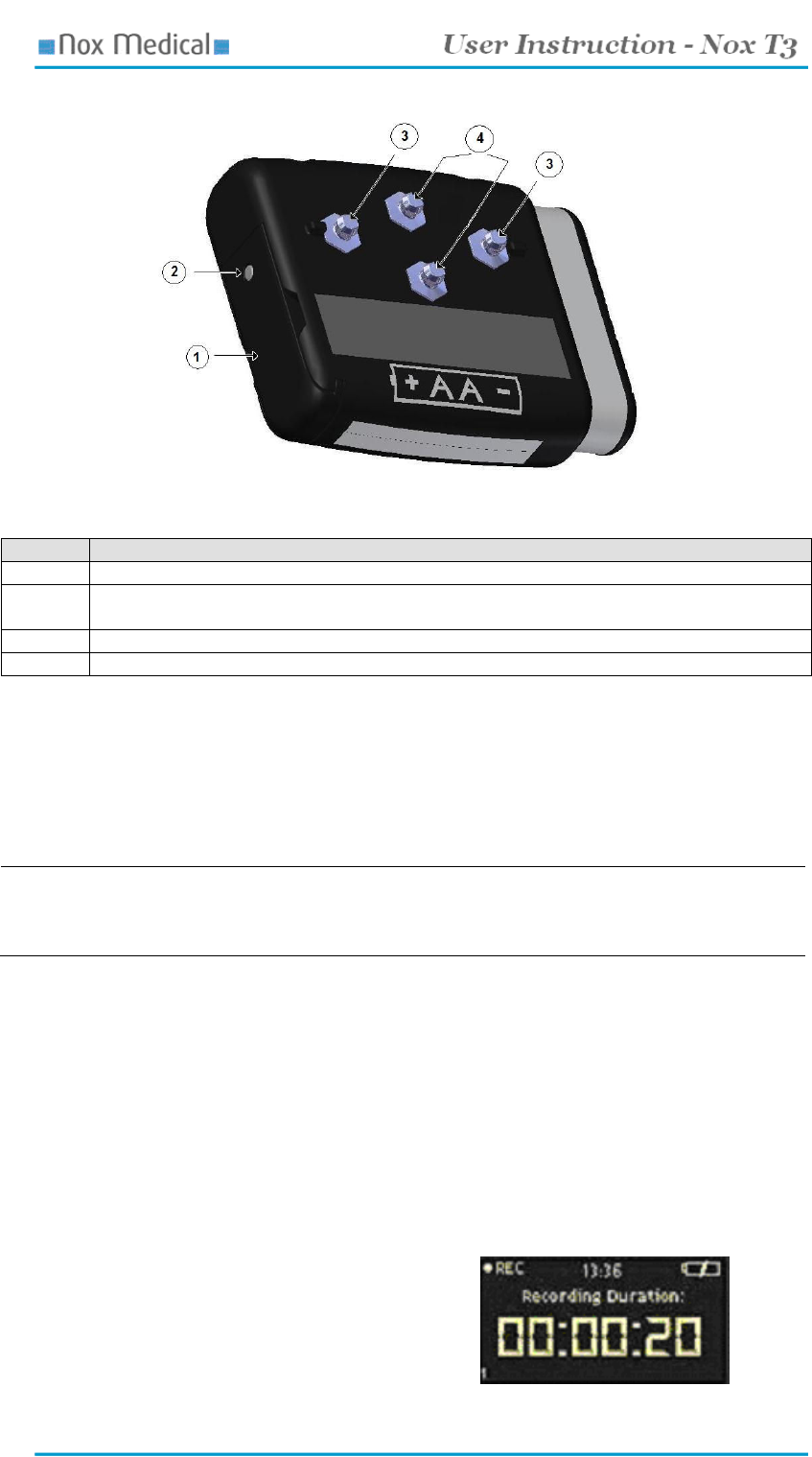
System Components ● 8
Number Function
1 Battery lid - Covers the battery and the USB connector
2 Battery compartment pin – Pressed down with a simple tool to open the battery
compartment
3 Metal snaps - Used to connect to thorax respiratory effort sensor
4 Metal snaps - Used to connect to abdomen-thorax cable
Starting/Stopping a Recording
The Select button located on the front panel of the device can be used to manually start and stop a
recording.
To manually start a recording: Hold down the Select button for at least 3 seconds
!
► The configuration of the device must have been set to Manually Start Recording, refer
to section Configuring the Device.
► The device must be disconnected from the PC (have a battery located in its battery
compartment) to be able to start a recording.
To stop the recording: Hold down the Select button for at least 3 seconds
To start the recording again: Hold down the Select button again for at least 3 seconds
Navigating the Nox T3 device
The device has three push buttons (Select, Backward and Forward) located on the front panel that are
used to get information on the recording taking place. Pressing the Forward button will navigate to the
next page and pressing the Backward button will navigate to the previous page.
To navigate the information pages during a recording perform the following steps:
1. Press the Select button to get
information on the duration of the
recording, actual time and battery
status.
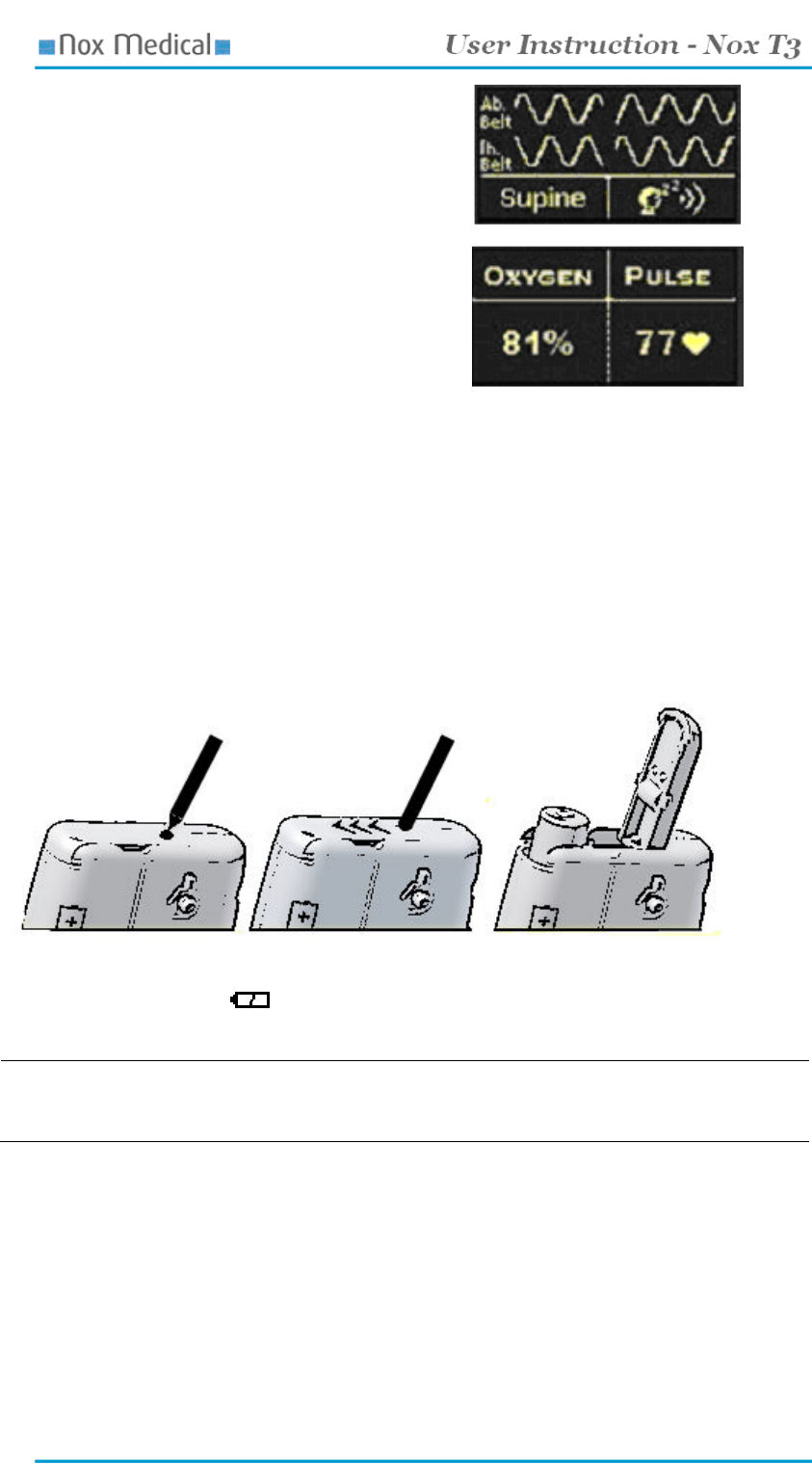
System Components ● 9
2. Then press the Forward button to view
the abdomen and thorax respiratory
effort signals being recorded, as well
as getting information of patient’s
position and whether a snoring signal
is being recorded.
3. Press the Forward button again will
show the actual oxygen saturation and
pulse rate of the patient.
Power
The Nox T3 device is powered by one AA battery. The battery lasts for a minimum of 3x 8 hours.
Inserting the Battery:
1. To open the battery compartment press down the battery compartment pin with a pen or
similar tool and slide the lid towards the bottom of the device
2. Place one AA battery in the compartment aligning the battery poles as illustrated on the back
of the device (the positive (+) pole is towards the battery lid)
3. Close the battery compartment by pressing the lid back towards the device without causing
any strain, then slide it back into position, towards the top of the device. Make sure the lid is
securely closed.
Checking the Battery:
The battery status indicator positioned in the upper right hand corner of the device’s display
allows the user to check the battery status during recording.
!
► To avoid risk of leakage, battery should not be stored in the device for a prolonged
period of time.
► Always use fully charged or fresh battery for each sleep study.
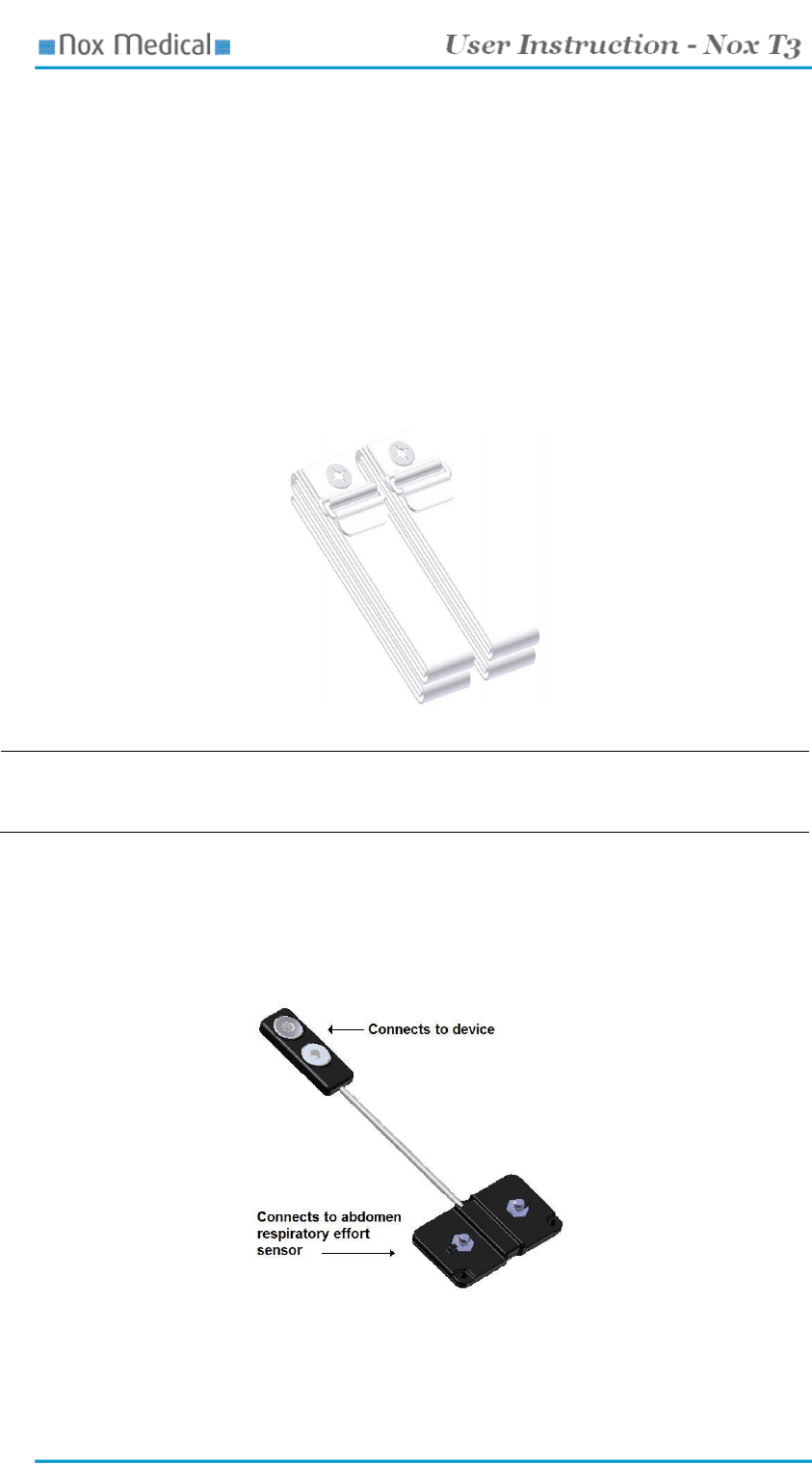
System Components ● 10
The Nox T3 Application – Noxturnal
The Nox T3 application (Noxturnal) is used to configure the device for recording, and downloading,
viewing and analyzing of recorded data. Refer to section Nox Noxturnal for detailed description.
Respiratory Effort Sensor (Belt)
The device uses two identical respiratory effort sensors to measure the respiratory effort of the patient.
One belt is placed around the patient’s abdomen and the other around the patient’s thorax. The belts
are made out of knitted elastic with insulated wire conductor and have a plastic glider for adjustment of
belt length. They are terminated with a metal snap at the ends that allows for the connection to the Nox
T3 device.
The belts are available in two versions and are adjustable to fit patient circumference from 40cm up to
205cm (Xin).
!
► The respiratory effort sensors should be worn over night-clothing or a T-shirt.
► The respiratory effort sensors are single patient use.
Abdomen –Thorax Cable
The abdomen-thorax cable connects together the abdomen respiratory effort sensor and the device via
metal snaps on each end of the cable. The cable is wrapped up around the abdomen end for adjustment
of length.
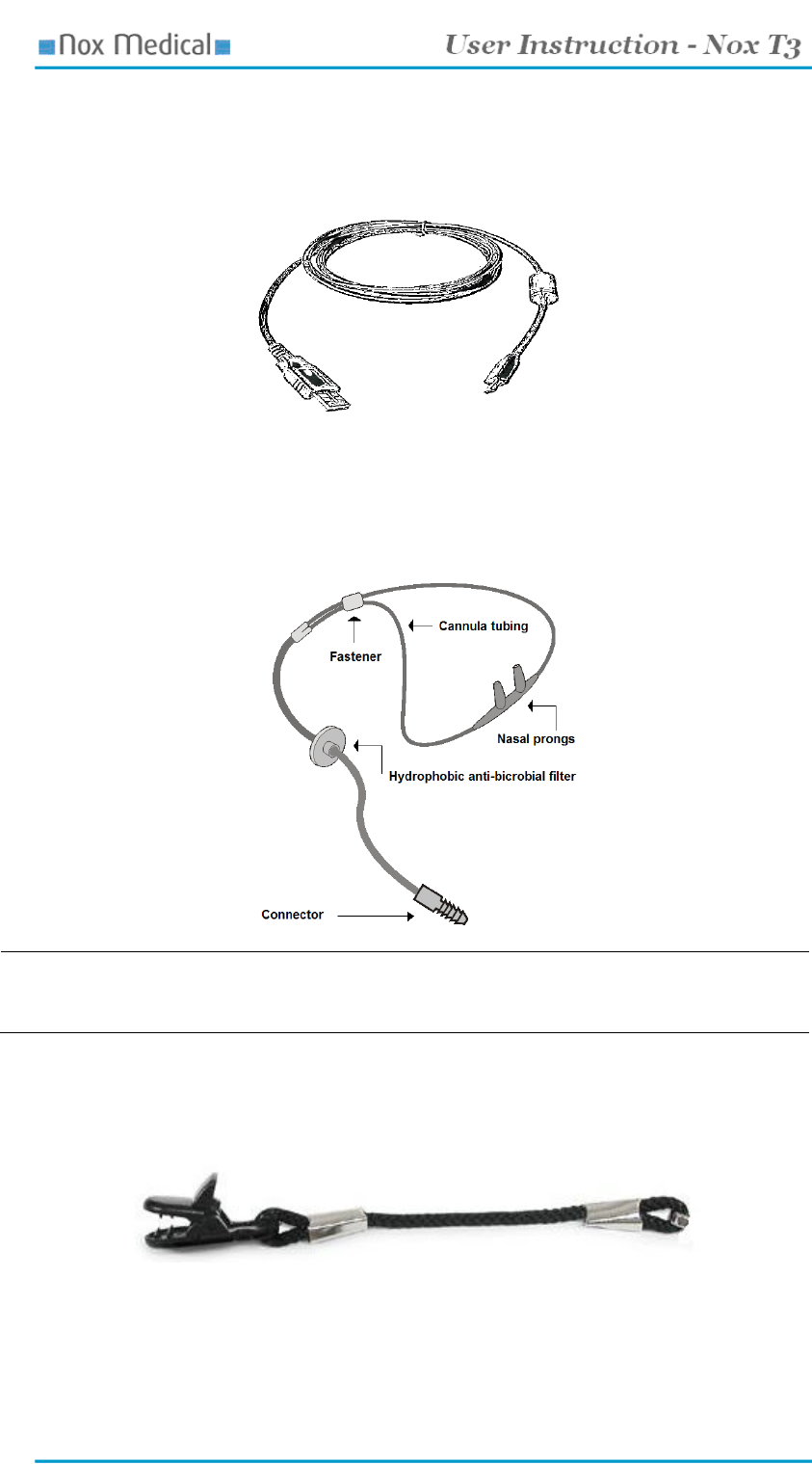
System Components ● 11
USB Cable
After the recording the data is downloaded from the device over USB by use of the proprietary USB
cable provided with the system.
Nasal Cannula
The nasal cannula is optional and connects to the pressure lock on the Nox T3 device for measuring of
airflow pressure. The nasal cannula is equipped with hydrophobic anti-microbial filter. The nasal
cannula is available in two versions, adult and pediatric.
!
► The nasal cannula is single patient use.
Clip Strap
The Nox T3 device is equipped with two clip straps, which are fastened to the night-clothing of the
patient to secure the position of the device during night.
Carry Bag
The carry bag is used to store the Nox T3 system and to carry around in.
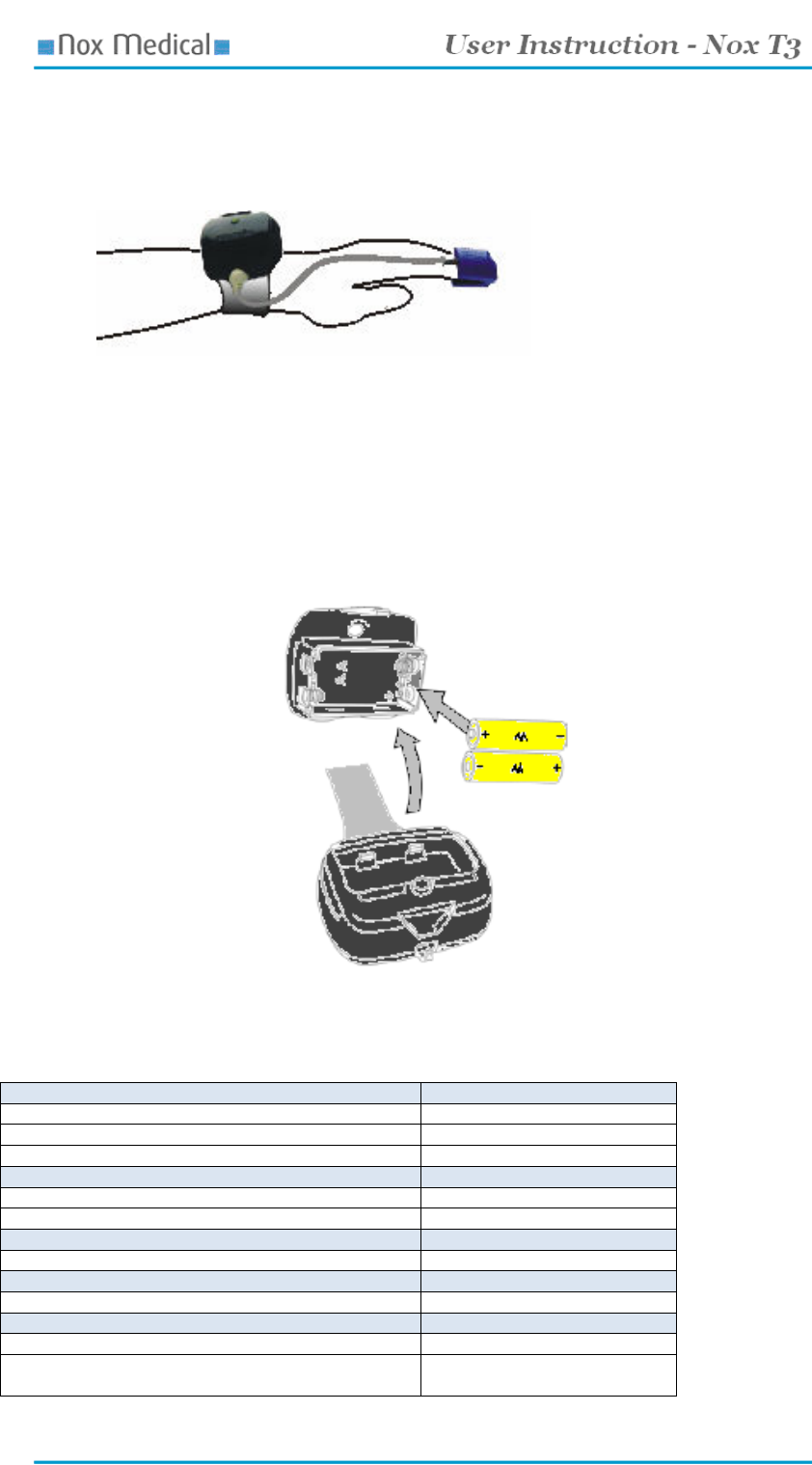
System Components ● 12
Pulse Oximeter
The Nonin pulse oximeter is an optional sensor which measures SpO2, pulse rate and
plethysmographic data. It is worn on the patient’s wrist and sends data to the Nox T3 device via
Bluetooth® wireless technology. The oximeter is battery powered.
Inserting Batteries
The Nonin pulse oximeter requires two AA alkaline batteries.
1. Remove the battery cover of the pulse oximeter to open the battery compartment
2. Place two AA batteries in the compartment aligning the battery poles as illustrated on the
bottom of the battery cover
3. Close the battery compartment. Make sure the cover is securely closed.
Oximeter Sensors
The Nonin oximeter pulse oximetry module supports all Nonin PureLightTM pulse oximeter sensors:
Nonin’s Models Soft Sensor - Reusable Preferred Application Site
Model 8000SL/SL-WO (large) Fingers, Toe
Model 8000SM/SM-WO (medium) Fingers, Toe
Model 8000SS/SS-WO (small) Fingers, Toe
Nonin’s Models Finger Clip Sensor - Reusable
Model 8000AA - Adult Index, middle or ring fingers
Model 8000AP - Pediatric Index, middle or ring fingers
Nonin’s Model s Ear Clip Sensor - Reusable
Model 8000Q
Ear lobe
Nonin’s Model s Reflectance Sensor - Reusable
Model 8000R Middle forehead
Nonin’s Models Flex Sensor - Reusable
Model 8000J + 8000JW -Adult Flex Sensor and Wrap
Index, middle or ring fingers
Model 8008J + 8000JFW -Infant Flex Sensor and Wrap
Toe, thumb, medial aspect of
hand

System Components ● 13
Nonin’s Model 8000 Reusable Sensors are indicated for spot-checking and/or continuous monitoring of
patients where little sensor motion is expected
ExG Sensors
The Nox T3 device is capable of recording any combination of two bipolar ExG channels, i.e. EMG,
EEG, EOG or ECG. The use of electrodes is optional and they connect to the bipolar touch proof
inputs on the device.
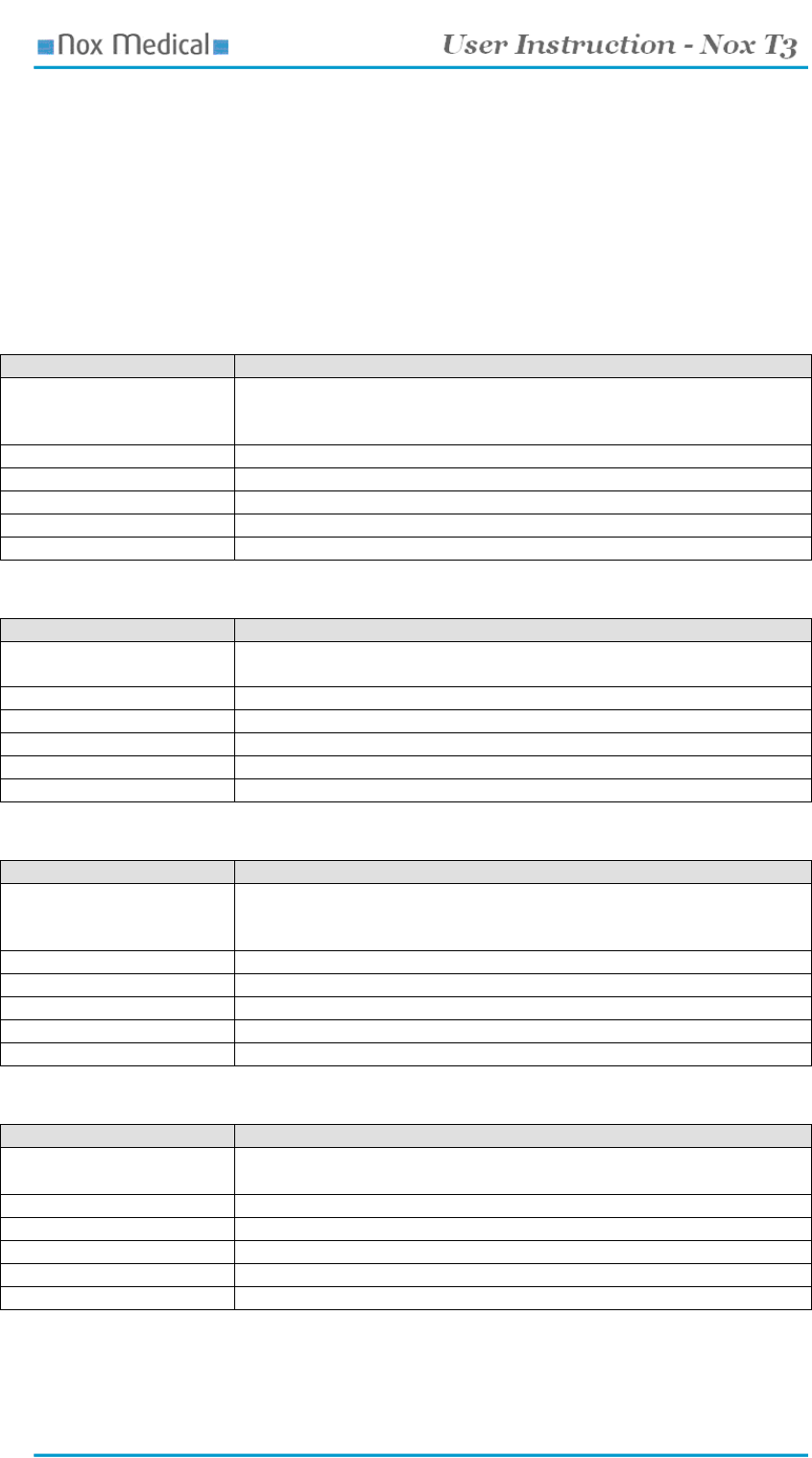
Hook-Up ● 14
Nox Noxturnal
The Noxturnal application interacts with the Nox T3 device. It allows the configuration of the device as
well as navigating, analyzing and archiving recordings from the device.
System Requirements
The following tables show the minimum and recommended hardware requirements needed to operate
the software effectively
Desktop Minimum System Requirements
Recommended
Operating System Windows® Vista (any version)
Windows® XP Home or Professional with Service Pack 2
Windows® Server 2003 with Service Pack 1
Processor X86 based Intel or AMD
Processor Clock Speed 1.7 GHz or faster
Memory 512 MB or more
Free Hard Drive Space 500 MB or more
Graphics Resolution 1024x768 or higher
Laptop Minimum System Requirements
Recommended
Operating System Windows® Vista (any version)
Windows® XP Home or Professional with Service Pack 2
Processor X86 based Intel or AMD
Processor Clock Speed 1.2 GHz or faster
Memory 512 MB or more
Free Hard Drive Space 500 MB or more
Graphics Resolution 1024x768 or higher
Desktop Recommended System Requirements
Recommended
Operating System Windows® Vista (any version)
Windows® XP Home or Professional with Service Pack 2
Windows® Server 2003 with Service Pack 1
Processor X86 based Intel or AMD
Processor Clock Speed 2.0 GHz or faster
Memory 1 GB or more
Free Hard Drive Space 500 MB or more
Graphics Resolution 1280x1024 or higher
Laptop Recommended System Requirements
Recommended
Operating System Windows® Vista (any version)
Windows® XP Home or Professional with Service Pack 2
Processor X86 based Intel or AMD
Processor Clock Speed 1.5 GHz or faster
Memory 512 MB or more
Free Hard Drive Space 500 MB or more
Graphics Resolution 1280x1024 or higher
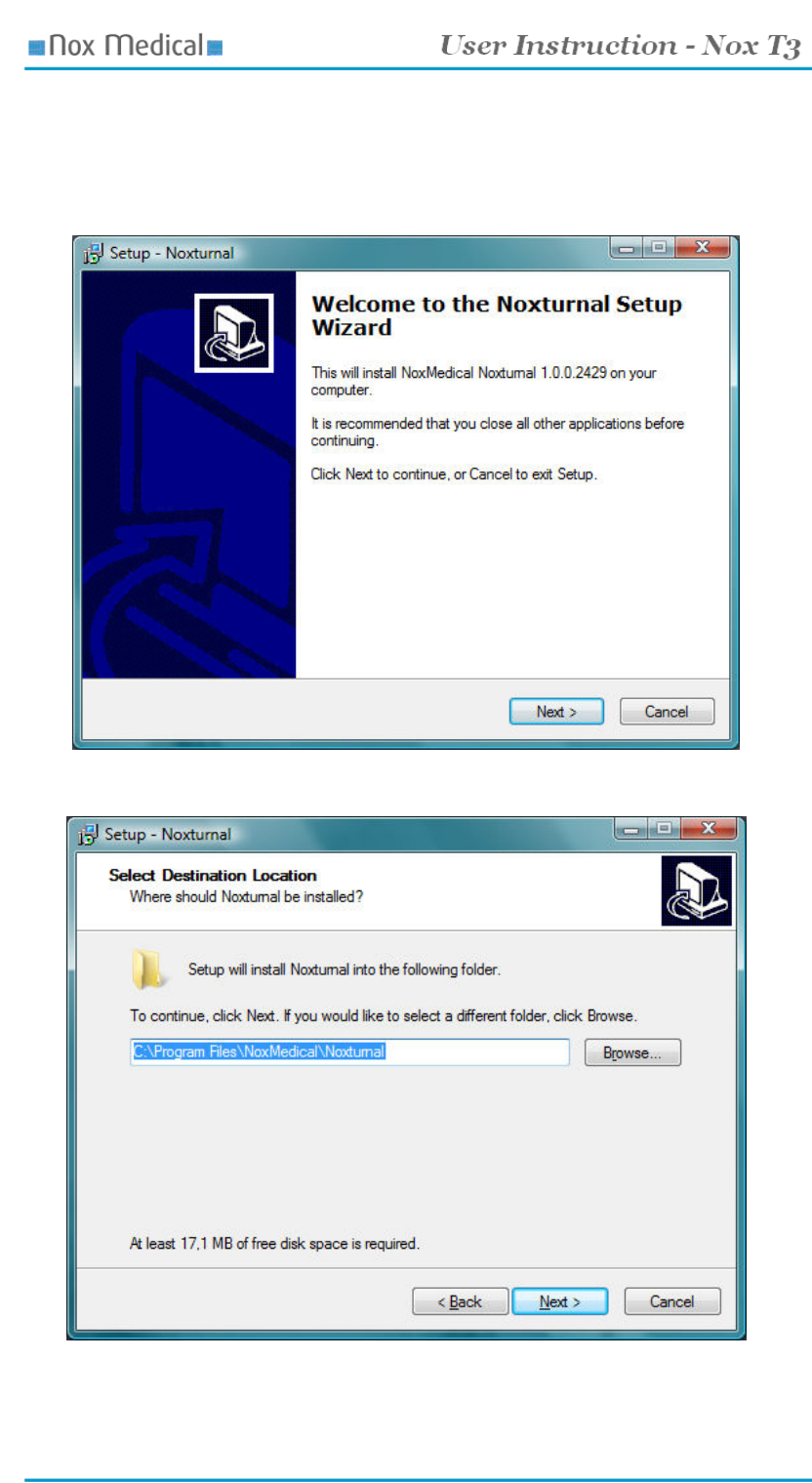
Hook-Up ● 15
Installation
Administrative privileges are needed to install Noxturnal. To install the application perform the
following steps:
1. Run the setup.exe file on the installation DVD
2. An installation wizard will appear: Press Next
3. Select an installation location and then press Next
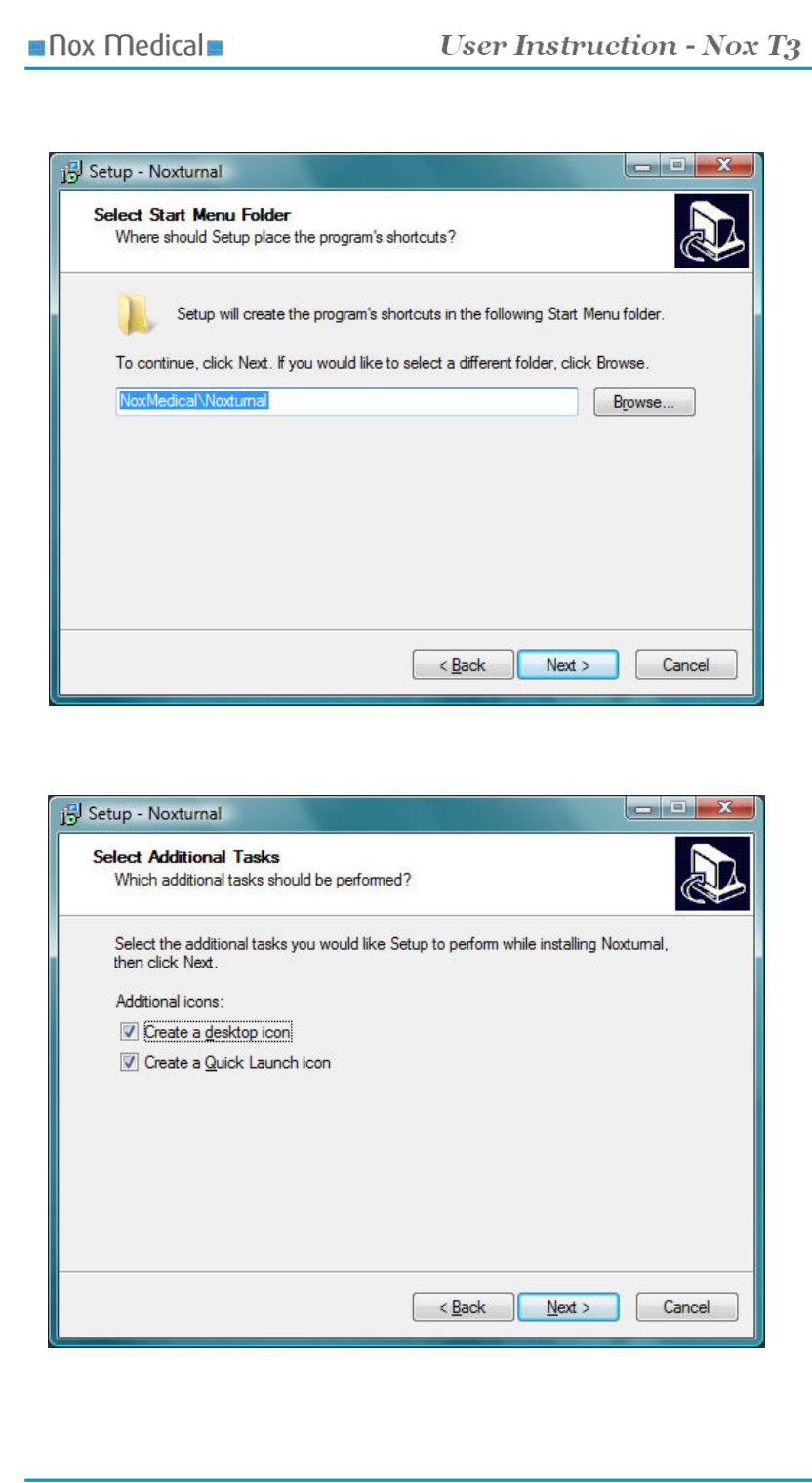
Hook-Up ● 16
4. Type in the location for the shortcut for the application and then press Next
5. This page gives the option of creating a desktop and a quick launch icon for the application.
Check the boxes as preferred and then press Next
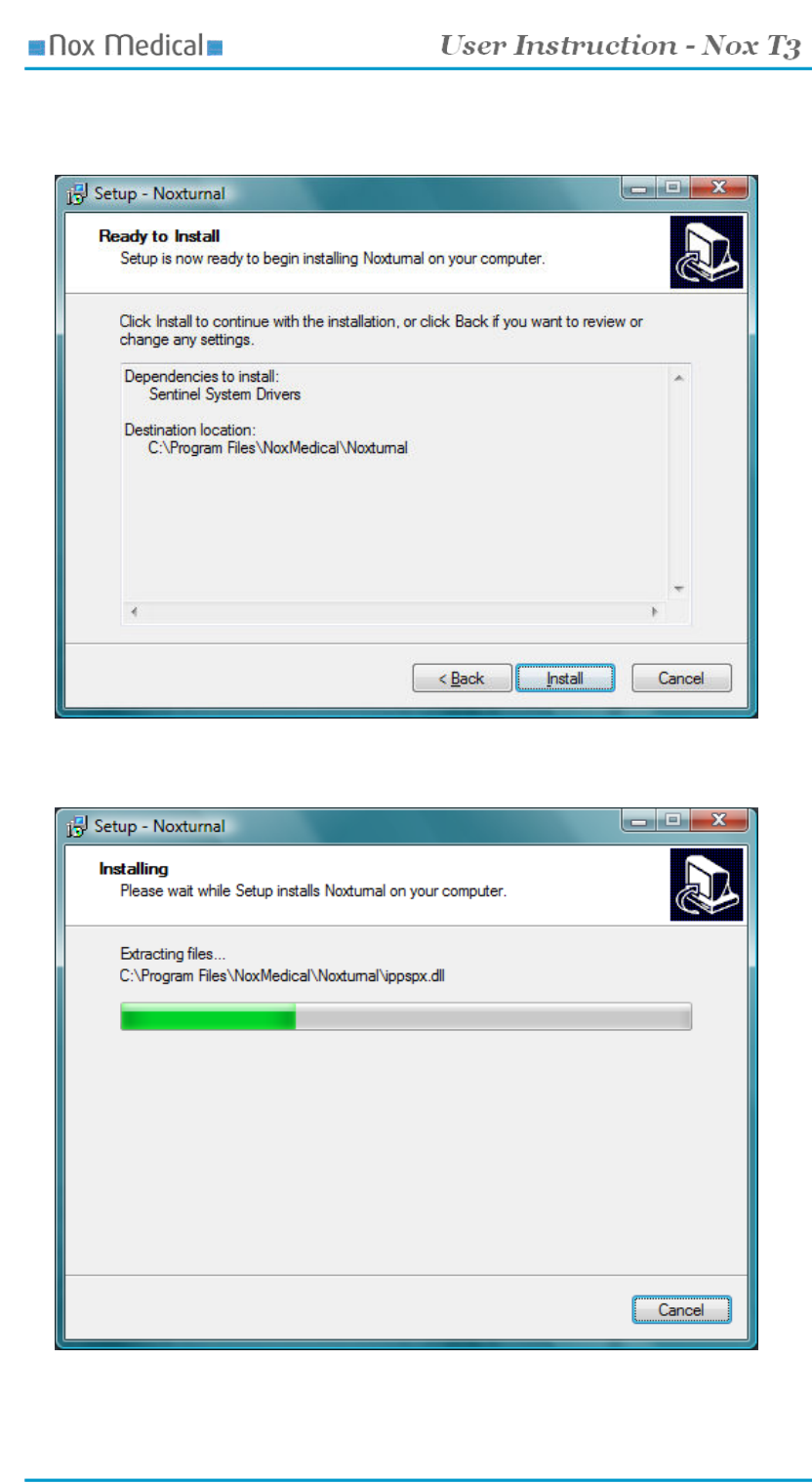
Hook-Up ● 17
6. This screen gives overview of where the application will be installed and additional items that
the application depends upon (dependencies). Press Install to accept otherwise press Back and
change your settings
7. The application is now being installed on your computer. The progress bar gives an indication
of the progress during installation
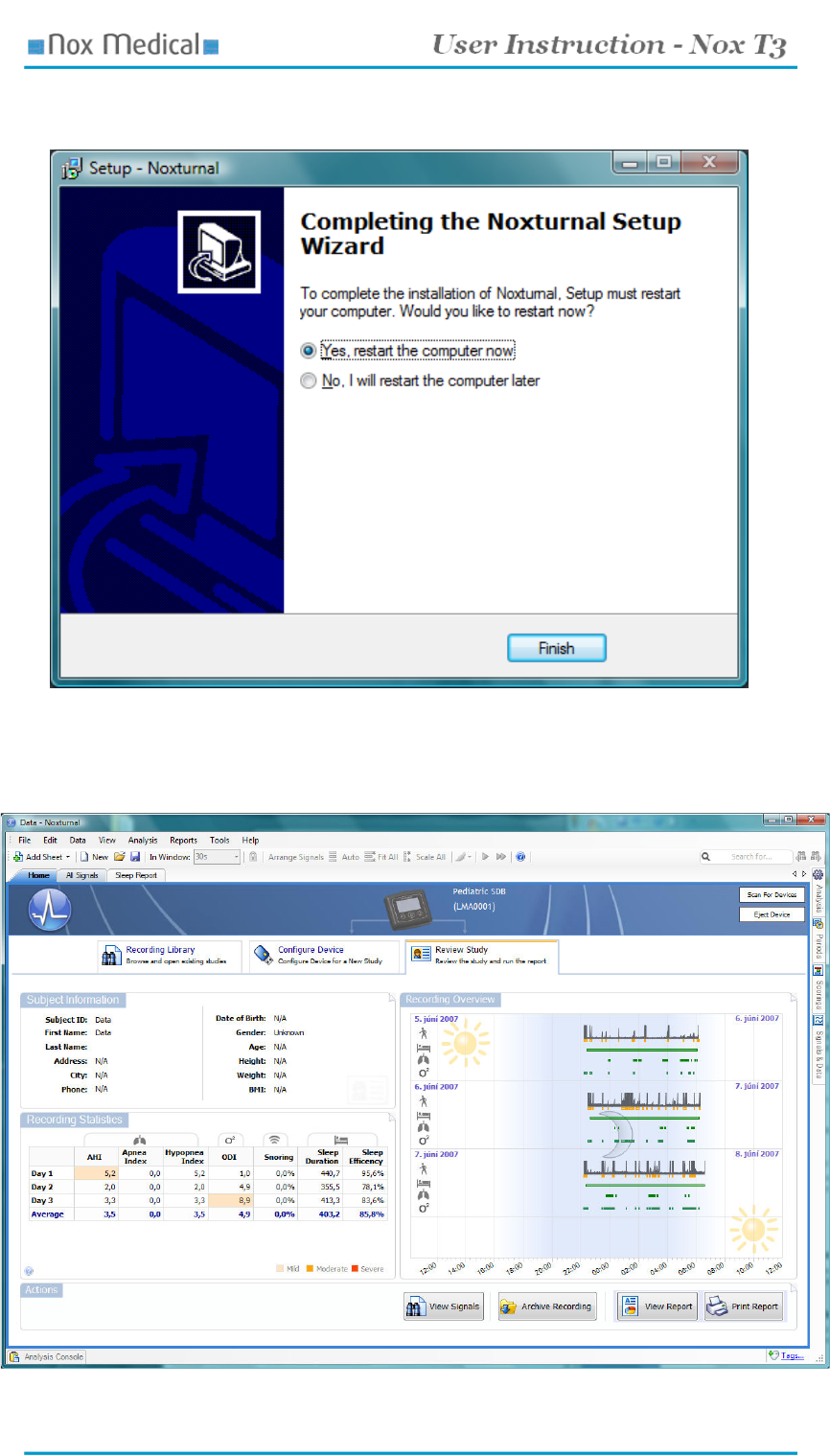
Hook-Up ● 18
8. After installation completes, you might be prompted to restart your computer, do so before
running the application. Select your option and then press Finish.
Running the software
When running the software, the first page that appears is the Start Page shown in the picture below.
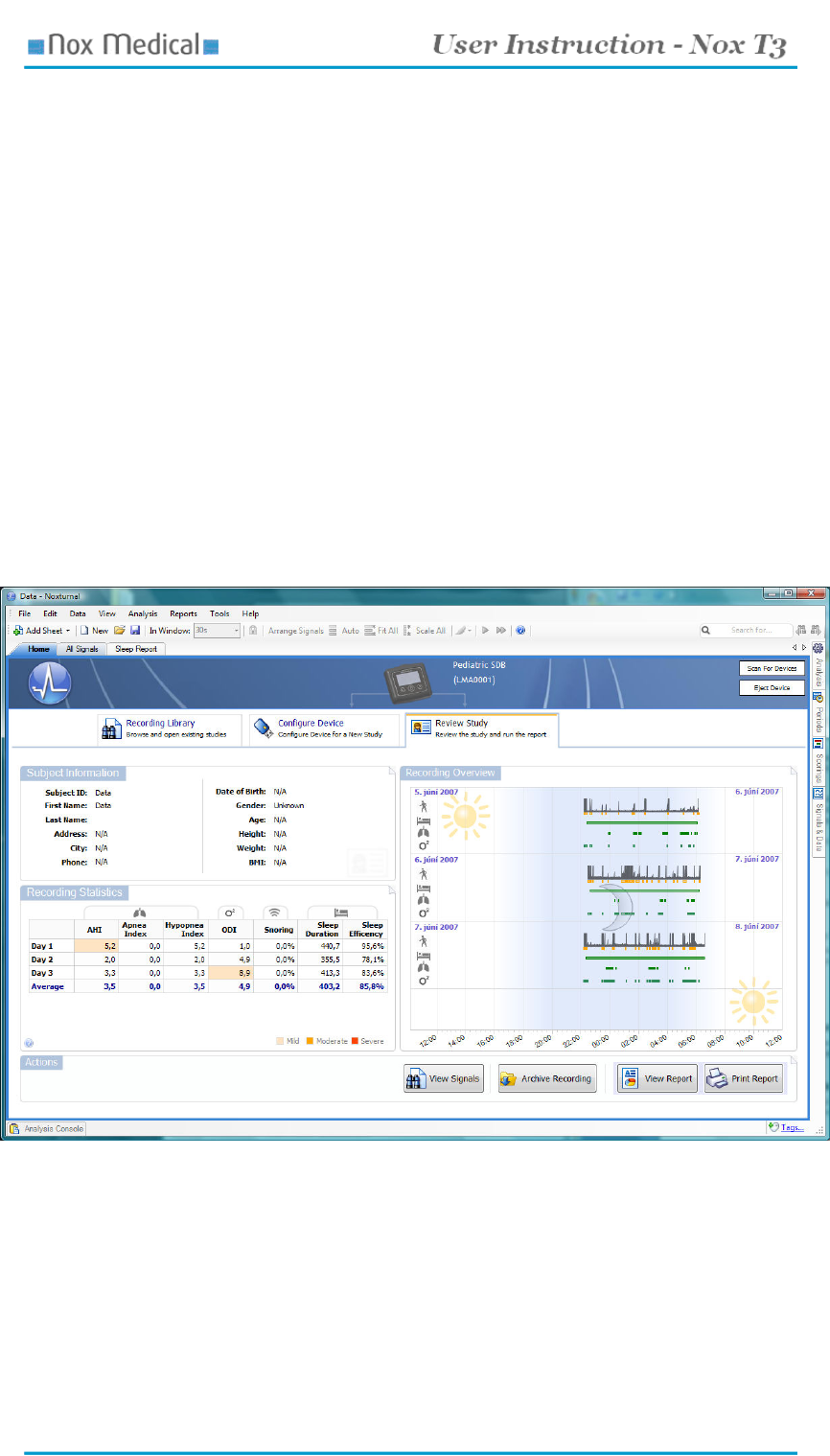
Hook-Up ● 19
The Start Page has three tabs:
• Recording Library: The Recording Library sheet lists recorded studies and gives access to
each one of those. By left clicking a recording on the Recording Library list, information
pertaining to that study will be shown on the right side of the page. Double clicking on a
recording in the Recording Library opens up that recording and shows it in the Review Study
sheet.
• Configure Device: The Configure Device sheet let’s you configure the device for a new
recording.
• Review Study: The Review Study sheet shows summary statistics for the recorded data and
gives an overview of that recording.
Configuring the Device
To configure the Nox T3 device perform the following steps:
1. Run the Noxturnal application
2. Connect your device to a USB port on your PC using the USB cable delivered with the
system.
3. The software automatically detects the device and switches to the Review Study tab. To
manually scan for an already connected device you can press the Scan for Devices button in
the upper right hand corner of the Start Page.
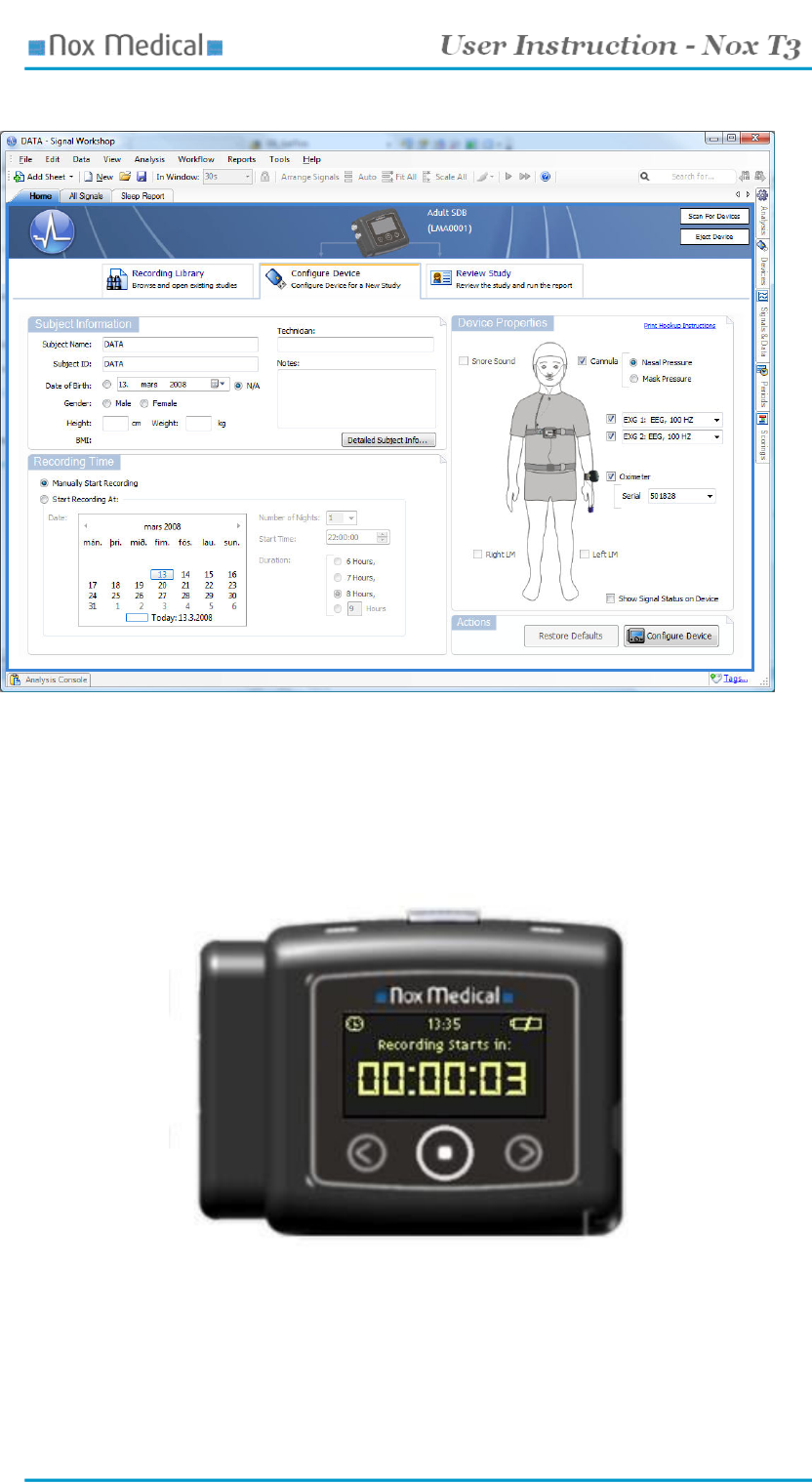
Hook-Up ● 20
4. Once the device is detected, press the Configure Device tab and view the following sheet:
5. Type in information about the subject being recorded in the Subject Info section, e.g. name,
age, address, gender, height and weight
6. Configure the conditions for starting the recording in the Recording Time section. The
simplest option is to Manually Start Recording. If you select this option, once disconnected,
the device will start its recording when you hold down its start/stop/select button for at least 3
seconds. See the picture below:
7. To start a recording at a given time and date, select the Start Recording At option, input the
date, number of nights, start time and duration. When selecting more than one consecutive
night of recordings each recording will start at the same time.
8. Select the applicable signals to be recorded in the Device Properties.
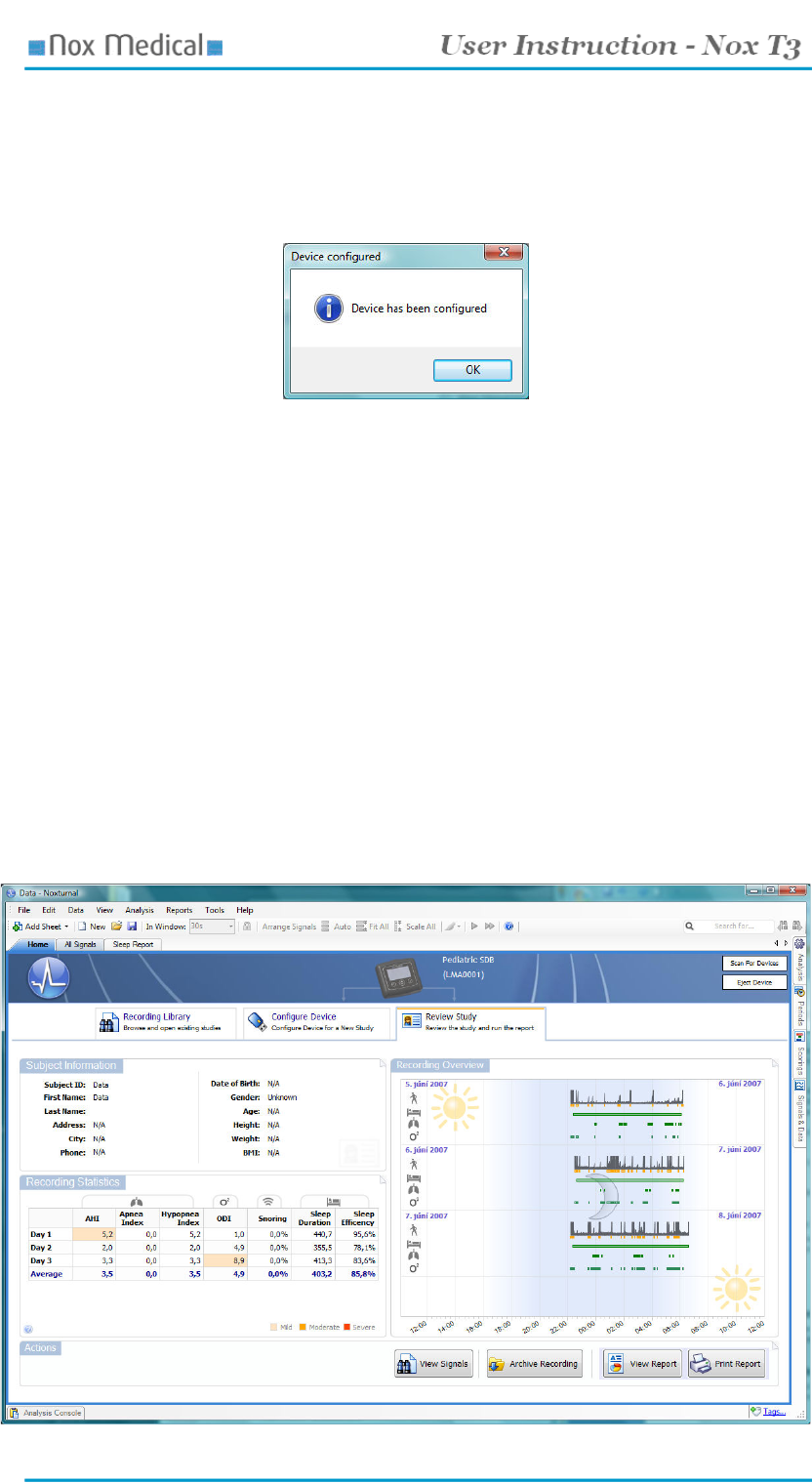
Hook-Up ● 21
9. To be able to use the pulse oximeter module in the recording it needs to be paired to the Nox
T3 device. Select the appropriate oximeter from the drop down list. In case the oximeter to
be used is not shown in the drop down list type in the ID code for that pulse oximeter,.
10. Once the configuration is done press the Configure Device button. A Device has been
configured button will be displayed.
11. Press the OK button and then disconnect the device.
Viewing Recorded Data
Before being able to view a recorded data in your PC you will need to upload the recording data to your
PC. Perform the following steps:
1. Run the Noxturnal application
2. Connect your device to a USB port on your PC using the USB cable delivered with the
system.
3. The software automatically detects the device and uploads and analysis the recording. During
this task you can view various recording data in the Review Study sheet:
a. Recording overview – an overview of the recorded signals and marked events for
each night recorded
b. Subject information - shows the subject information entered when preparing the
study
c. Recording statistics - a table of key sleep parameters that help with diagnosing the
recording data
See picture below:
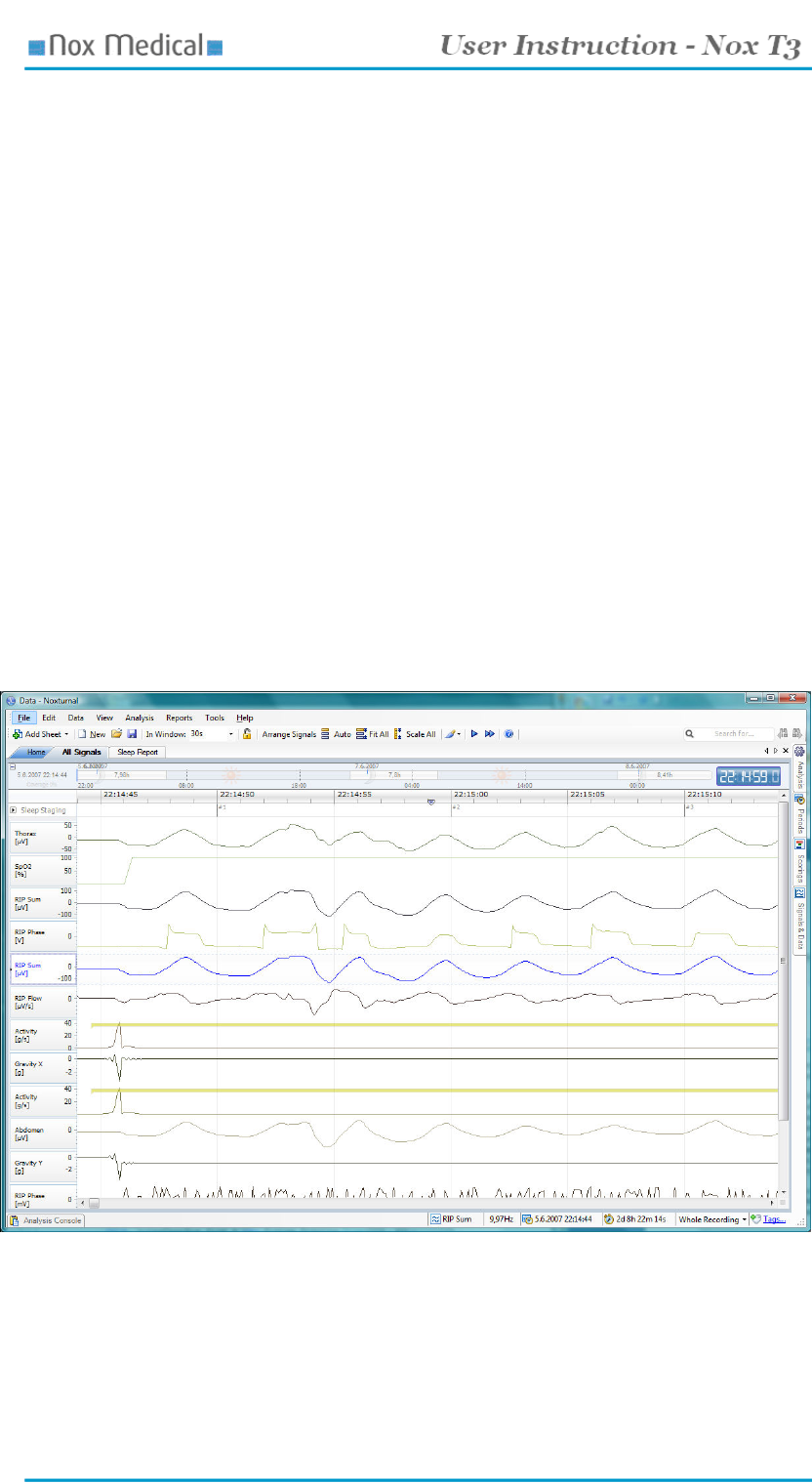
Hook-Up ● 22
Recording statistics: A table containing key parameters of statistics calculated from the raw
underlying data and marked events for each night recorded:
• AHI (number of Apneas + Hypopneas per hour),
• Apnea Index (number of Apneas per hour),
• Hypopnea Index (number of Hypopneas per hour),
• ODI (number of desaturation events per hour),
• Snoring (percentage of breaths with snoring),
• Sleep Duration (number of minutes where the subject was treated as sleeping)
• Sleep Efficiency (Sleep Duration / Total Duration).
Recording Overview: Gives an overview for each night recorded, including:
• Activity
• Movement scored
• Estimated time in bed
• Apneas/Hypopneas scored
• Desaturation events.
The Actions section located at the bottom of the Review Study page shows options for working with the
recorded data, including:
• View Signals - For browsing through the recorded signals and viewing the marked events
• Archive Recording - For archiving the recording to a different location
• View Report - Shows a report summarizing the recording parameters
• Print Report - Prints a report summarizing the recording parameters.
The View Signals action gives access to the recorded signals, see picture below:
When viewing the signals it is possible to navigate in time by pressing the left/right arrow keys, the
Page-Up/Page-Down keys or by scrolling via a mouse-wheel or mouse-pad.
The Archive Recording action copies the recorded data to an archive location. The archive location can
be set via the Tools – Options – Data Locations menu option.
The View Report action shows a printable report with key information helpful for the physician and the
subject:
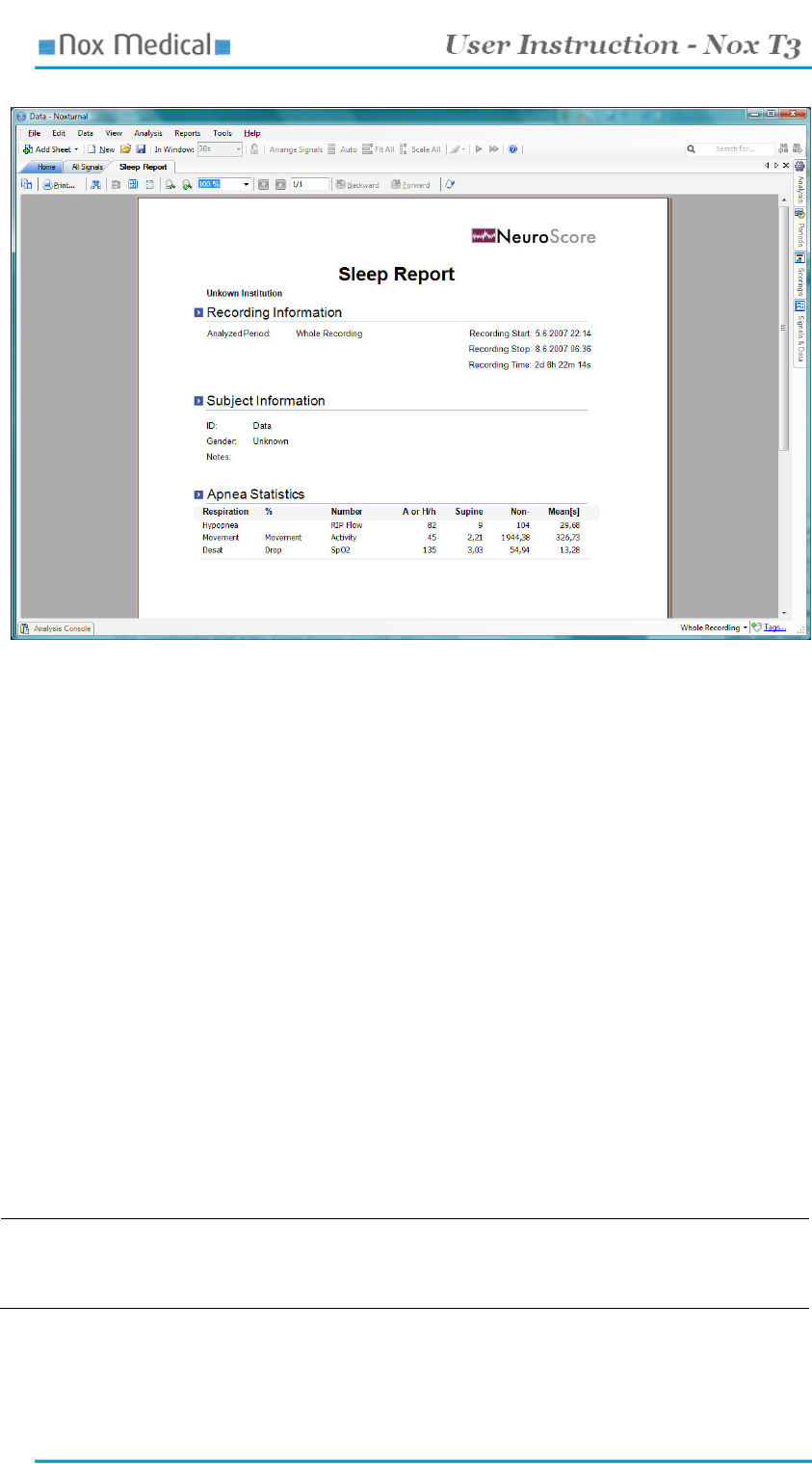
Hook-Up ● 23
The Print Report action directly prints out the report above.
Hook-Up
It is assumed that the clinician will demonstrate the use of the device and applicable sensors to the
patient, or in the case of pediatrics to the parents, and the hook up then takes place at home by using a
detailed instruction for hook up. In some cases the clinician may prepare the patient partly or
completely.
Go through the following points with the patient:
1. Applying of device and sensors
2. Testing of sensor connections
3. Status indications on the display including warnings
4. Replacement of battery
It is important to remind the patient to follow the instructions given prior to the study.
Before sending the patient home:
1. Make sure the device has been configured correctly
2. Make sure the carry bag contains all equipment needed to finish the study, including batteries
3. Provide the patient with the Nox T3 Hook Up Card
!
► Children should under no occasion hook up the system.
► Do not use damaged equipment like sensors or accessories.
► As with all medical equipment, carefully route cables and connections to reduce the
possibility of entanglement or strangulation
Attaching the Device and the Respiratory Effort Sensors
Step 1: Attach the device to the patient’s
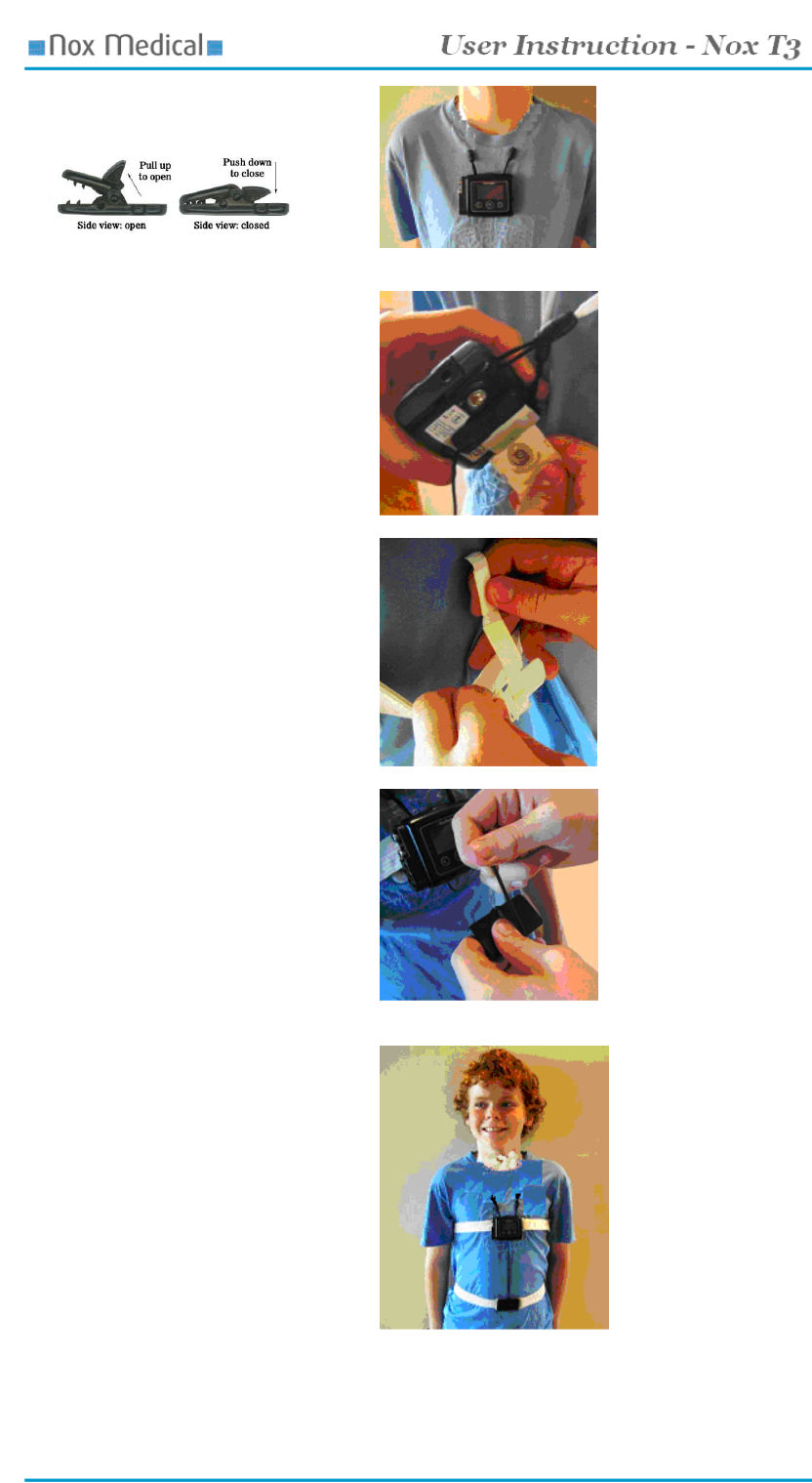
Hook-Up ● 24
thorax by fasten the clip strap to the night-
clothing of the patient
Step 2: Place the respiratory effort sensor
around the patient’s thorax by snapping its
ends to the back panel of the device
Step 3: The belt length is adjusted using the
sliders. The slider is fixed by the Velcro and
secured by the attached tape.
Step 4: The abdomen - thorax cable is
snapped to the back of the device and the
cable length adjusted if needed by wrapping
it up around the abdomen end
Step 5: The abdomen belt is snapped to the
abdomen cable and the length adjusted if
needed (see step 3)
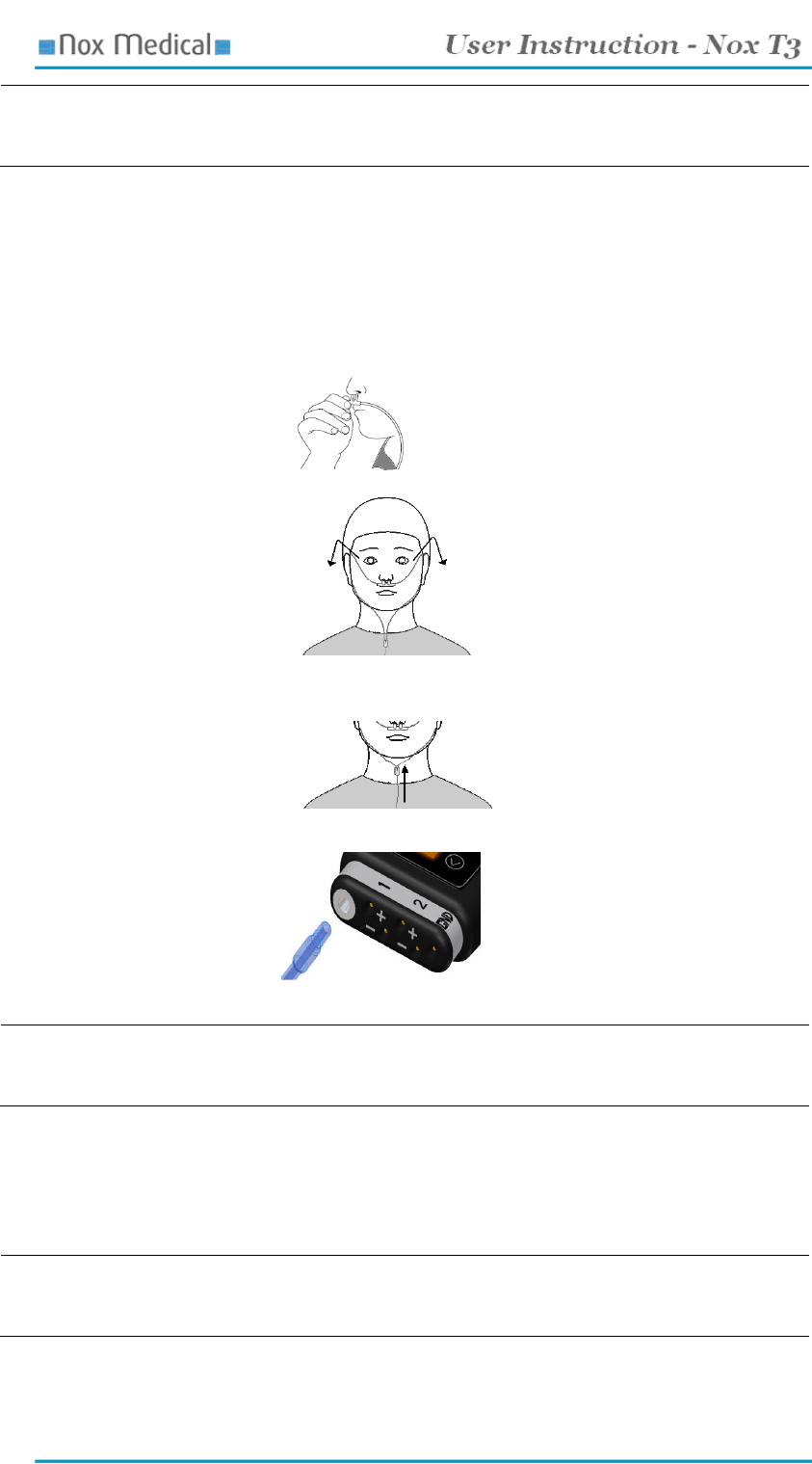
Hook-Up ● 25
!
► The device and respiratory effort sensors (belts) should be worn over night-clothing.
► The belt should fit the patient snugly without being uncomfortably tight.
Recording of Respiratory Sounds and Snoring
No applying of external sensor is needed for recording of respiratory sounds and snoring as the devices
uses an inbuilt microphone.
Applying the Nasal Cannula
Step 1: Place the nasal prongs
gently in the nostrils
Step 2: Drape the cannula
tubing over the ears and then
position it under the chin
Step 3: Slide the fastener snugly
under the chin to hold the
cannula tubing securely in
place.
Step 4: Connect the nasal
cannula connector to the
pressure lock on the device
!
► Medical tape can be used to hold the cannula against the cheeks to secure the cannula
in place if necessary
► The nasal cannula is single patient use
Attaching Electrodes
The electrodes are placed on applicable locations on the body depending on the type of study.
!
► Make sure the skin is clean before applying the electrode
► The ExG sensors are single use.
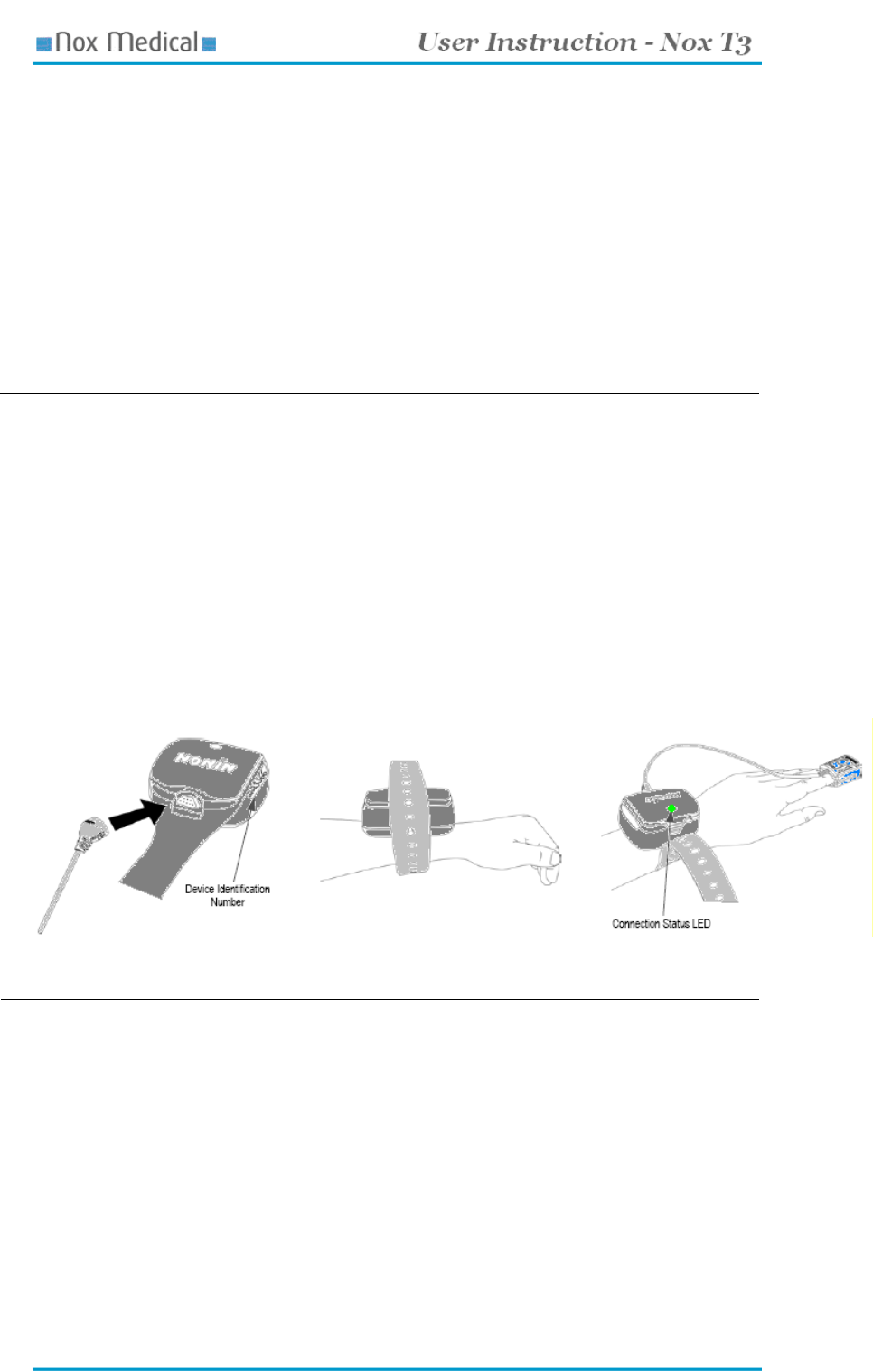
Hook-Up ● 26
Pulse Oximeter Module
Choosing the Appropriate Pulse Oximerer Sensor
Use the measurements provided in the user instructions accompanying the sensor to determine which
size of sensor should be used. Sensor size recommendations are based on digit height (thickness).
!
► Use only NONIN manufactured PureLight
TM
pulse oximeter sensors. These sensors
are manufactured to meet the accuracy specifications for NONIN pulse oximeters. Using
other manufacturers’ sensors can result in improper pulse oximeter performance.
► To avoid the risk of confusing or misinterpreting patient data, verify that the patient
module is paired with the correct Nox T3 device.
► This pulse oximetry system might misinterpret motion as good pulse quality.
Minimize finger motion or change the type of sensor being used.
Attaching the Pulse Oximeter Module and Sensor
1. Attach the sensor to the pulse oximeter module. Press firmly to make sure the sensor is
securely connected. The pulse oximeter is automatically activated when an oximeter sensor is
connected.
2. Secure the wristband to the patient’s wrist
3. Insert the selected digit (refer to the sizing recommendations in the user instructions
accompanying the sensor) into the sensor. The patient’s digit must reach the end of the
sensor.
4. Direct the cable along the patient’s finger/toe, parallel to the arm/leg
5. Verify proper operation:
- The connection status LED flashes green when a connection is established
- It flashes amber if no connection is established.
The wristband can either be reused or discarded after each use, as desired. It may be cut to length to
accommodate a variety of patient arm sizes.
!
► Proper sensor placement is critical for good performance. If the sensor is not
positioned properly, light may bypass the tissue and result in SpO
2
inaccuracies.
► Do not fasten the pulse oximeter too tightly around the patient’s wrist. Inaccurate
readings and patient discomfort could result.
►Do not use a damaged sensor. If the sensor is damaged in any way, discontinue use
immediately and replace the sensor.
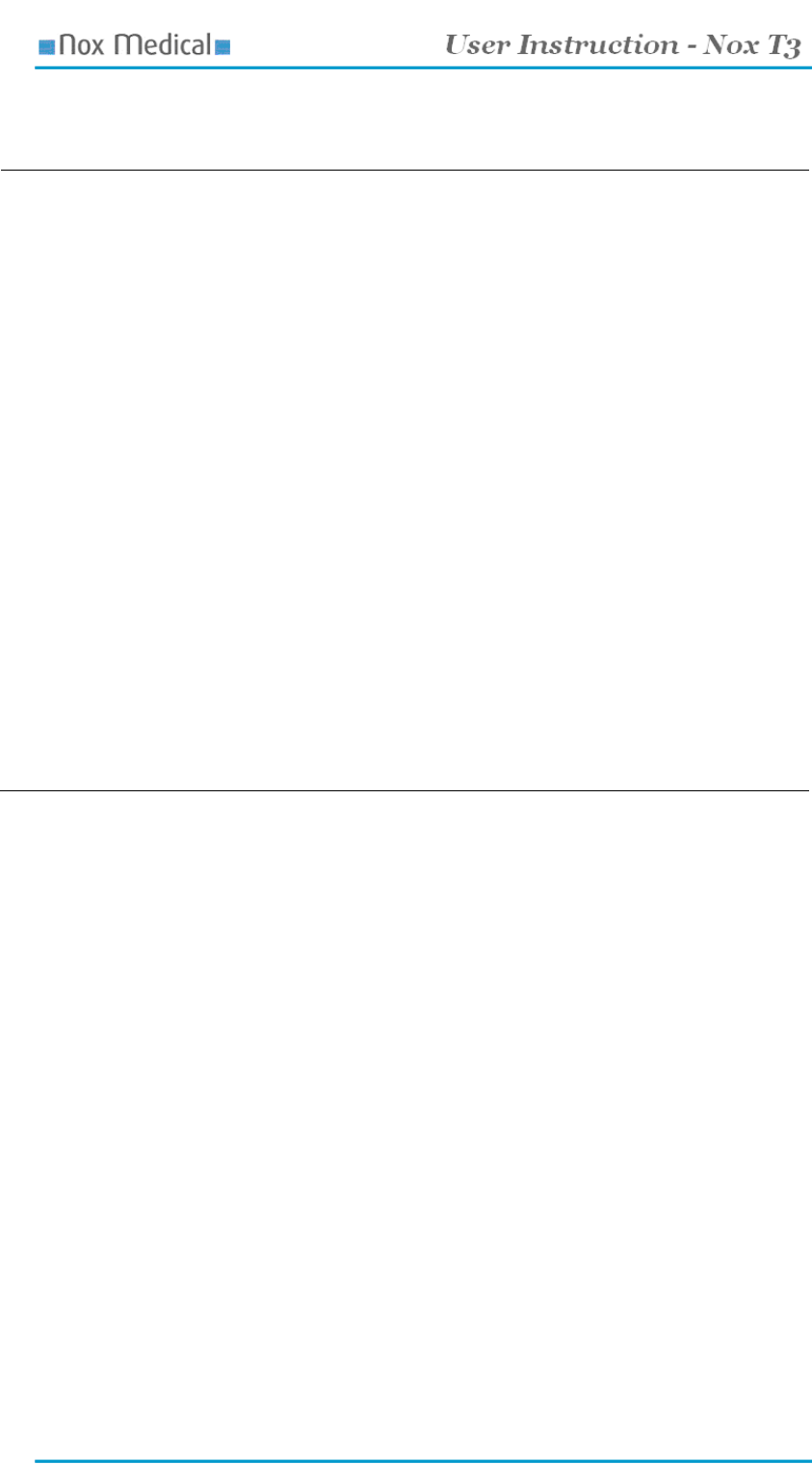
Hook-Up ● 27
Precautions for Use of the Pulse Oximeter
!
► Oximeter readings may be affected by the use of an electrosurgical unit (ESU)
► This pulse oximetry system is designed to determine the percentage of arterial oxygen
saturation of functional hemoglobin. Significant levels of dysfunctional hemoglobin,
such as methemoglobin, might affect the accuracy of the measurement.
►To prevent improper performance and/or patient injury, verify sensor and pulse
oximeter compatibility before use.
►A functional tester cannot be used to access the accuracy of a pulse oximeter monitor
or probe.
► Factors that may degrade pulse oximeter performance include the following
- excessive ambient light
- excessive motion
- electrosurgical interference
- arterial catheter, blood pressure cuffs, infusion lines, etc.
- moisture in the sensor
- improperly applied sensor
- carboxyhemoglobin
- methemoglobin
- artificial nails
- incorrect sensor type
- poor pulse quality
- venous pulsations
- anemia or low hemoglobin concentrations
- cardiovascular dyes
- sensor not at heart level
- dysfunctional hemoglobin
- fingernail polish
►Refer to instruction for use accompanying the pulse oximeter and oximeter sensor for
additional warnings and cautions.
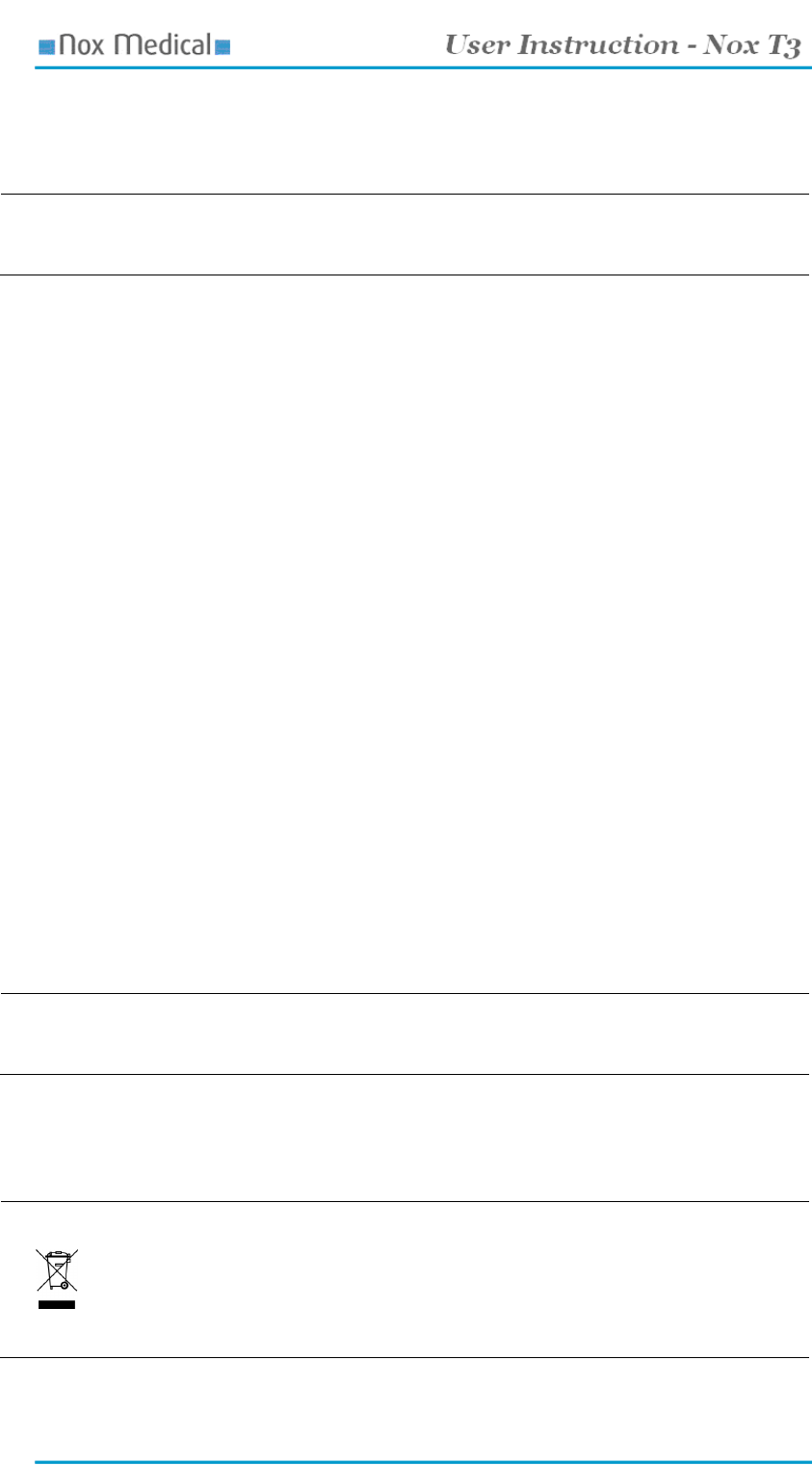
System Maintenance ● 28
System Maintenance
No special maintenance of the Nox T3 system is needed.
!
► Remove batteries if the system is not used within 30 days.
Calibration
The Nox T3 device is factory calibrated. No further calibration needed.
Cleaning
No part of the Nox T3 system requires sterilization.
Nox T3 Device: Clean the device with a soft cloth dampened with hospital grade cleaner that is not
corrosive to plastic or metal. Do not pour or spray any liquids onto the device, and do not allow any
liquids to enter any openings in the device. Allow the unit to dry thoroughly before use.
Cables: Clean the cables with a moist cloth using hospital grade cleaner. Do not immerse the cables in
liquid and avoid contact of the cleaning solution with the connectors.
Pulse Oximeter Module: Clean the module with a soft cloth dampened with isopropyl alcohol. Do
not pour or spray any liquids onto the device, and do not allow any liquids to enter any openings in the
device. Allow the unit to dry thoroughly before use.
Pulse Oximeter Sensor (Model 8000): Unplug the sensor from the pulse oximeter module before
cleaning or disinfecting. Clean the sensor by wiping all patient contact surfaces with a soft cloth
dampened in water or a mild soap solution. To disinfect the sensor, wipe all patient contact surfaces
with isopropyl alcohol (IPA).
For other types of pulse oximeter sensors refer to the sensor package inserts.
Respiratory effort sensors: The belts are one-time adjustable disposable belts and non washable.
Nasal cannula: The cannula is single patient use and shall not be sterilized.
!
► Clean the device separately from its associated sensors.
► Do not autoclave or immerse any device equipment or sensor in any kind of liquid.
► Do not use caustic or abrasive cleaning agents on the units.
Disposal
Follow local governing ordinances and recycling instructions regarding disposal or recycling of this
device and accessories, including batteries.
►According to the regulation in Europe on Waste of Electrical and Electronic
Equipment (WEEE) the equipment and its’ accessories may not be disposed of as
unsorted municipal waste. The equipment shall be collected separately and
returned to the appropriate collection system available.
►Please contact your distributor regarding take-back or recycling of the
equipment. If you are unsure how to reach your distributor, please call Nox
Medical for your distributor’s contact information.
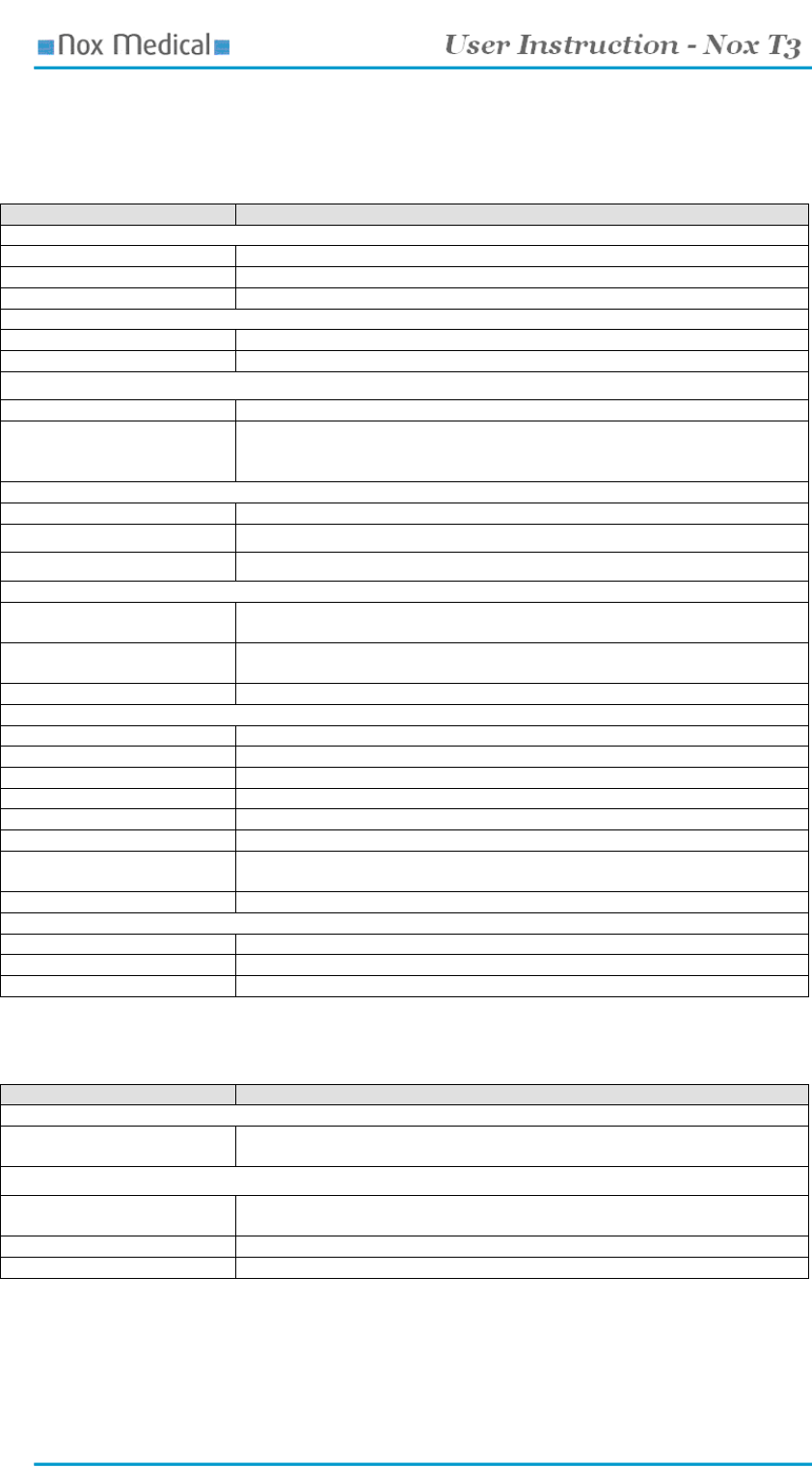
Specification ● 29
Specification
Nox T3 Device
Description Properties
Function
Storage capacity 1GByte
Recording time Nominal 24 hours with new or fully charged battery
Bipolar inputs Touch proof DIN 42-802
Physical
Device Dimension 79mm (3.11”) W, 63mm (2.48”)H, 21mm(0.83”) D
Weight 65 gram (88 gram with battery)
Power
Internal Power One 1.5V AA battery
Type - Alkaline primary or
- Alkaline rechargeable) or
- Nickel-metal hydride (NiMH)
Display
Type OLED
Display Dimension 19x35mm
Resolution 128x64 dots
Environmental Condition
Temperature Operation: +5°C to +50ºC (40°F to 120º F)
Storage: -20°C to +50ºC (0°F to 120º F)
Rel. Humidity Operation: 15-95% (non-condensing)
Storage: 10-95% (non-condensing)
Pressure Withstands atmospheric pressures from 0.5 to 2 bar
Transmitter
Bluetooth® compliance Version 2.0
Operating frequency 2.402-2.480 GHz
Output Power < 2 mW
Network Topology Point-to-Point: Point-to-Multipoint
Operation Scatter-Net Master
Antenna Type Internal
Modulation Type Frequency Shift Keying
Frequency Hopping Spread Spectrum
Bandwidth 1 MHz
Material
Enclosure ABS
Snaps Stainless steel
Pressure port Stainless steel
Respiratory Effort Sensor
Description Properties
Physical
Size Paediatric version adjustable from 40cm to 110cm
Adult version adjustable from 70cm to 205cm
Material
Belt Polyester
Latex free
Slider Polypropylene (PP)
Snap wire Spring steel
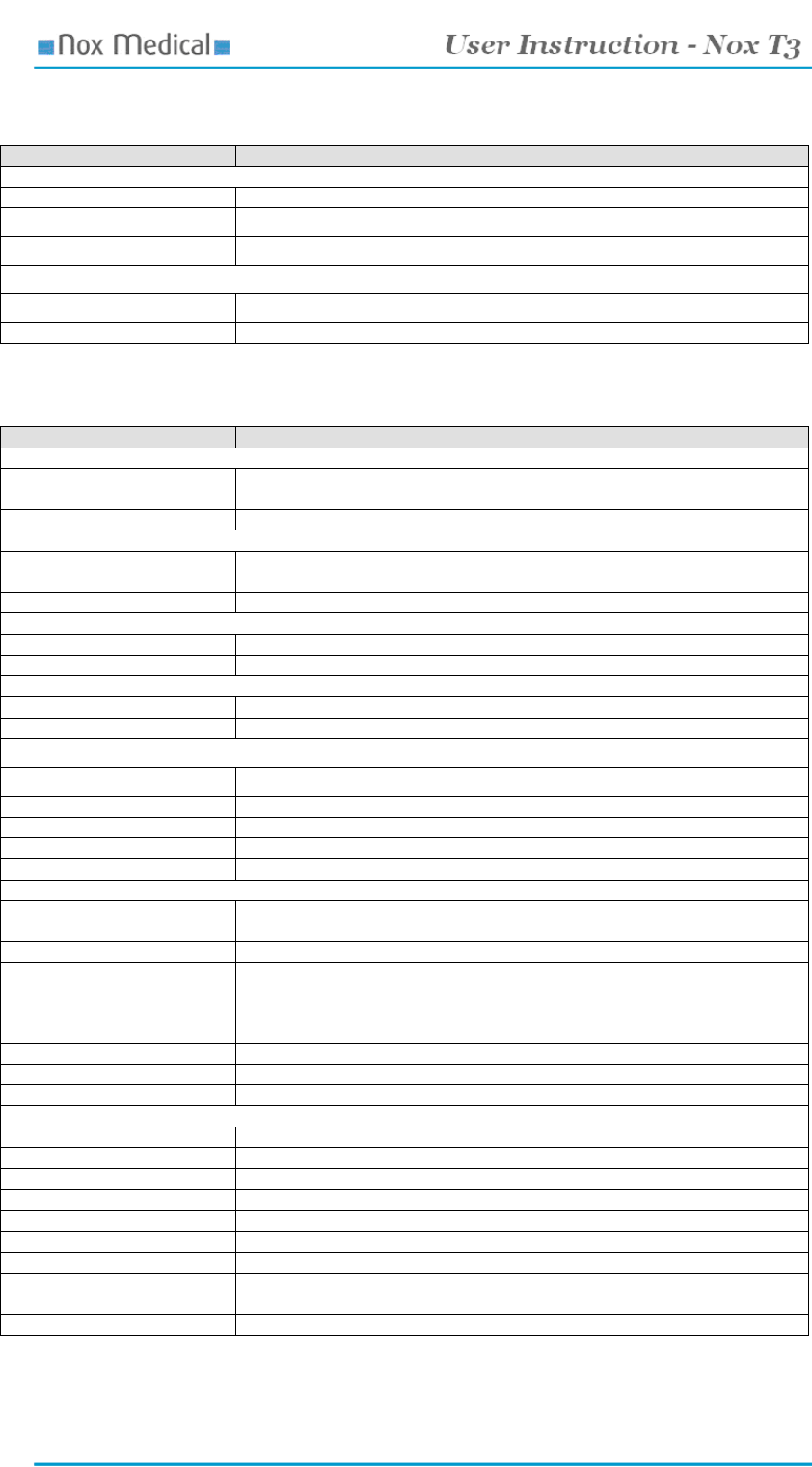
Specification ● 30
Nasal Cannula
Description Properties
Physical
Filter Hyrophilic Filer with Female Luer Lock Inlet
Environmental
Storage Store in a cool dry place
Material
Cannula PVC/Silicon
Filter Acryl
Pulse Oximeter Module
Description Properties
Range
Oxygen Saturation Range
(%SpO2)
0-100%
Pulse Rate Range 18-300 pulse per minute
Accuracy
Blood Oxygen Saturation
(%SpO2) ( ± 1 S.D.)
70-100% ± 2 digits for adults using 8000AA-WO Finger clip sensor
Pulse Rate ± 3%
Displays
Connection status LED Amber or green
Recording time Up to X hours
Measurement Wavelengths and Output Power
Red 660 nanometers @ mW nominal
Infrared 910 nanometers @ mW nominal
Internal Power
Battery Two 1.5V AA batteries
Operating Life Minimum 120 hours of continuous operation with new batteries
Storage Life 10 months
Weight 4.4 ounces with batteries (125g)
Environmental Condition
Temperature Operation: 0°C to +50ºC (32°F to +122º F)
Storage/Transportation: -30°C to +50ºC (-22°F to +122º F)
Operating Altitude Up to 40,000 feet
Humidity Operation: 10-90% (relative humidity, non-condensing)
Storage/Transportation: 10-95% (relative humidity, non-condensing)
If transferred from a non-operating temperature and/or humidity condition,
allow at leas one hour of stabilization time before use.
Hyperbaric Pressure Up to 4 atmospheres
Antenna Type Inverted F type antenna
Antenna Gain + 2dB (typical), +3 dB (max)
Transmitter
Bluetooth® compliance Version 1.1
Operating frequency 2.4-2.4835 GHz
Output Power < 1.1 mW
Operating Range 10 meter radius indoors
Network Topology Point-to-Point
Operation Slave: Model 4100
Antenna Type Internal
Modulation Type Frequency Shift Keying
Frequency Hopping Spread Spectrum
Bandwidth 1 MHz
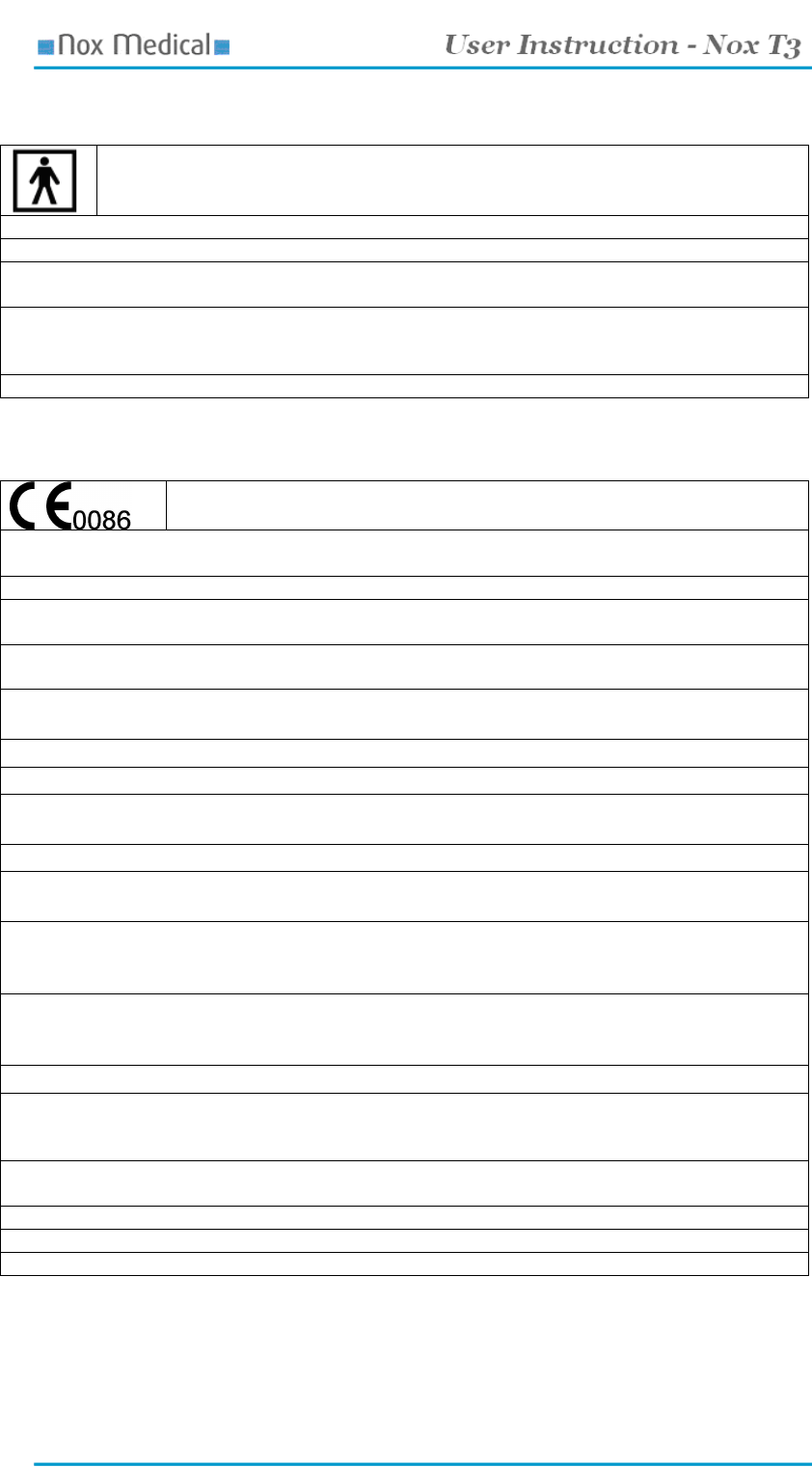
Specification ● 31
Classifications
► Degree of protection (applied part) against electric shock: The device is classified as
of type BF.
►Powering of device: The device is internally powered
► Mode of operation: The device is intended for CONTINUOUS OPERATION.
► Degree of protection against ingress of liquids: The device is classified as an ordinary equipment
regarding ingress of liquids, i.e. it is not drip-proof, splash-proof or watertight.
► Use with Flammable Anesthetics: The device is not suitable for use in presence of a
FLAMMABLE ANAESTHETIC MIXTURE WITH AIR or WITH OXYGEN or NITROUS
OXIDE.
► Installation/use of device: The device is classified as a portable device.
Certifications
The Nox T3 device complies with the following directives and standards:
► Annex V of the Medical Device Directive 93/42/EEC and is certified by BSI
to carry the CE label
►IEC 60601-1 Medical electrical equipment – Part 1: General requirements for basic safety and
essential performance
►UL 60601-1 Medical Electrical Equipment, - Part 1: General Requirements for Safety (USA)
►CAN/CSA C22.2 NO. 601.1 - M90 Medical Electrical Equipment - Part 1: General Requirements
for Safety (Canada)
►IEC 60601-1-2 Medical electrical equipment - Part 1-2: General requirements for safety -
Collateral standard: Electromagnetic compatibility - Requirements and test
►
IEC 60601-1-4 Medical electrical equipment - Part 1-4: General requirements for safety -
Collateral Standard: Programmable electrical medical systems
►
IEC 60601- 2-25 Particular requirements for the safety of electrocardiographs
►
IEC 60601- 2-26 Particular requirements for the safety of electroencephalographs
►
IEC 60601- 2-40 Particular requirements for the safety of electromyographs and evoked response
equipment
►
ISO 14971 Medical devices - Application of risk management to medical devices
►
ISO 13485 Medical devices – Quality Management systems – Requirements for regulatory
purposes. The manufacturing site of the Nox T3 device is certified according to ISO 13485.
►
EN 300 328 Electromagnetic compatibility and Radio Spectrum Matters (ERM); Wideband
Transmission systems; Data transmission equipment operating in the 2,4 GHz ISM band and using
spread spectrum modulation techniques
►
EN 301 489-17
Electromagnetic compatibility and radio spectrum matters (ERM);
Electromagnetic compatibility (EMC) standard for radio equipment and services; Part 17: Specific
conditions for wideband data and HIPERLAN equipment
►
EN 60950-1
Information technology equipment – Safety - General requirements
►EN 50371 Generic Standard to Demonstrate the Compliance of Low-Power Electronic and
Electrical Apparatus with the Basic Restrictions Related to Human Exposure to Electromagnetic
Fields (10 MHz–300 GHz) – General Public
►FCC Part 15 The device has been tested and found to comply with the limits for a Class B digital
device, pursuant to Part 15 of FCC Rules.
► RSS 210 of IC The device complies with RSS 210 of Industry Canada (IC)
► RSS-GEN Issue 1 The device complies with RSS-GEN Issue 1 of Industry Canada (IC)
►Bluetooth® compliance

Specification ● 32
EMC – Information
Declaration of Conformity with USA Federal Communications
Commission (FCC) and Canadian Ministry of Health Rules for
Electromagnetic Compatibility
The Nox T3 device complies with Part 15 of the FCC Rules and RSS 210 of Industry Canada.
Operation is subject to the following two conditions:
1. This device may not cause harmful interference, and
2. This device must accept any interference, including interference that may cause undesired
operation of this device.
For questions regarding your product or this FCC declaration, please contact:
Fusion Sleep Therapy Services LLC
4265 Johns Creek Parkway, suite A
Suwanee
GA 30024
USA
Phone: 678 990 3262
Fax: 678 990 3966
Email: reception@fusionsleep.com
This equipment has been tested and found to comply with the limits for a Class B digital device,
pursuant to Part 15 of FCC Rules. These limits are designed to provide reasonable protection against
harmful interference in a residential installation. This equipment generates, uses, and can radiate radio
frequency energy. If not installed and used in accordance with the instructions, it may cause harmful
interference to radio communications. However, there is no guarantee that interference will not occur in
a particular installation.
If this equipment does cause harmful interference to radio or television reception, which can be
determined by tuning the equipment off and on, the user is encouraged to try and correct the
interference by one or more of the following measures:
• Reorient or relocate the receiving antenna.
• Increase the distance between the equipment and the receiver.
• Connect the equipment to outlet on a circuit different from that to which the receiver is
connected.
• Consult the dealer or an experienced radio/TV technician for help.
Modification Statement
The FCC requires the user to be notified that any changes or modifications not expressly approved by
Nox Medical could void the user's authority to operate the equipment.
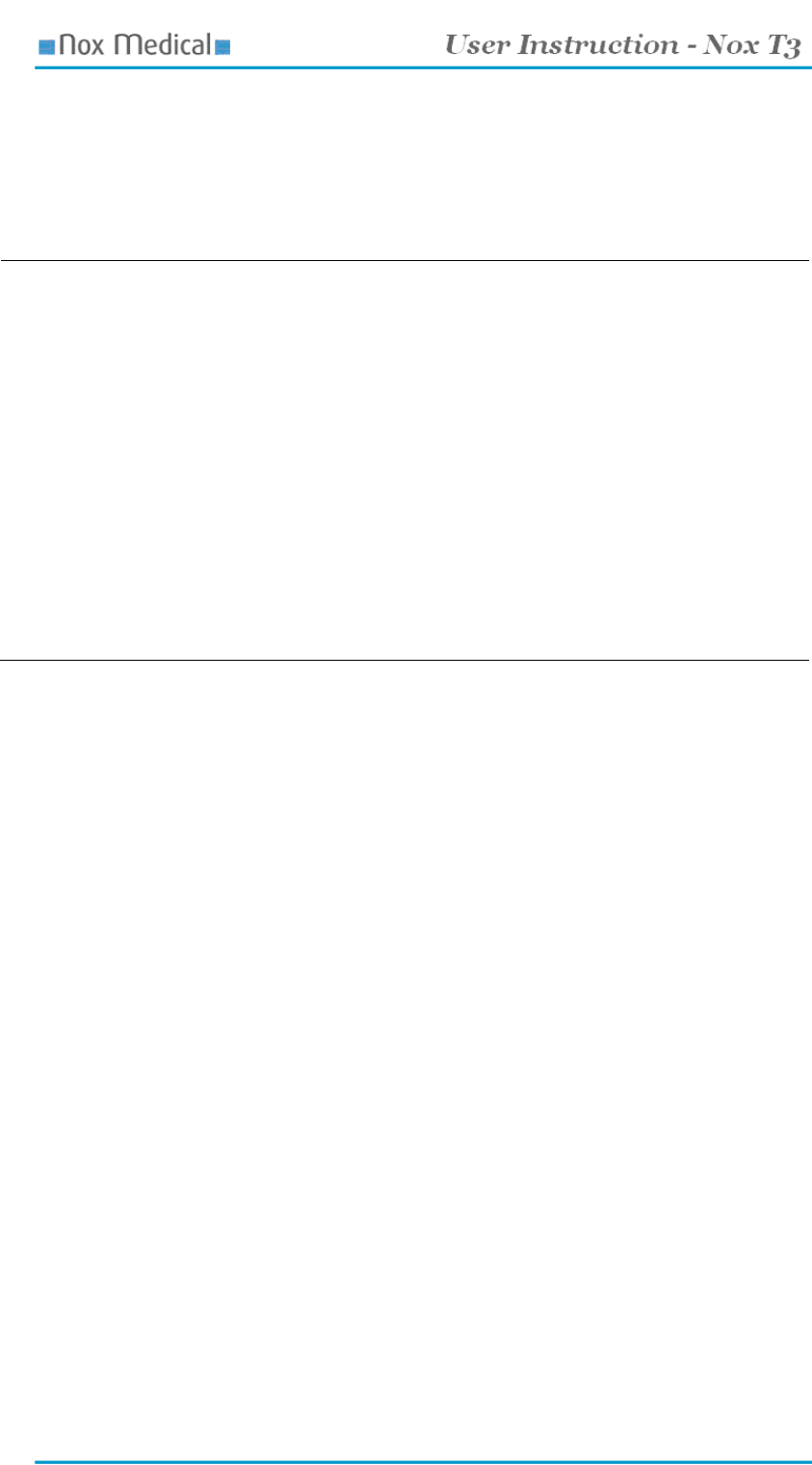
Specification ● 33
Specific Absorption Rate (SAR)
Ministry of Health (Canada), Safety Code 6: standards include substantial safety margin designed to
ensure the safety of all persons, regardless of age and health. The Specific Absorption Rate or SAR is
a measure of the rate at which electromagnetic energy is absorbed into the body. The SAR limit for the
general public is 1.6W/kg for the trunk and 4W/kg for the limbs.
!
► This product emits radio frequency energy, but the radiated output power of this
device is far below the FCC radio frequency exposure limits. Nevertheless, the device
should be used in such a manner that the potential for human contact with the antenna
during normal operation is minimized.
► Caution: Exposure to radio frequency radiation.
► Portable and mobile RF communications can affect the performance of the device.
► The device should not be used adjacent to, or stacked with, other equipment. If
adjacent or stacked use is necessary, the device should be observed to verify normal
operation in the configuration in which it will be used.
► Electrostatic discharges (ESD) may cause artifacts in the signal from the device.
Avoid conditions where electrostatic charge can build up because of low humidity and
friction against carpets, clothing and sheets made from artificial fibers.
► The use of accessories, sensors, and cables other than those listed in this manual may
result in increased emission and/or decreased immunity of this device.
► This system may be interfered with by other equipment, even if that equipment
complies with CISPR emission requirements.
► Refer to the tables in this section for specific information regarding the device’s
compliance to the standard IEC60601-1-2
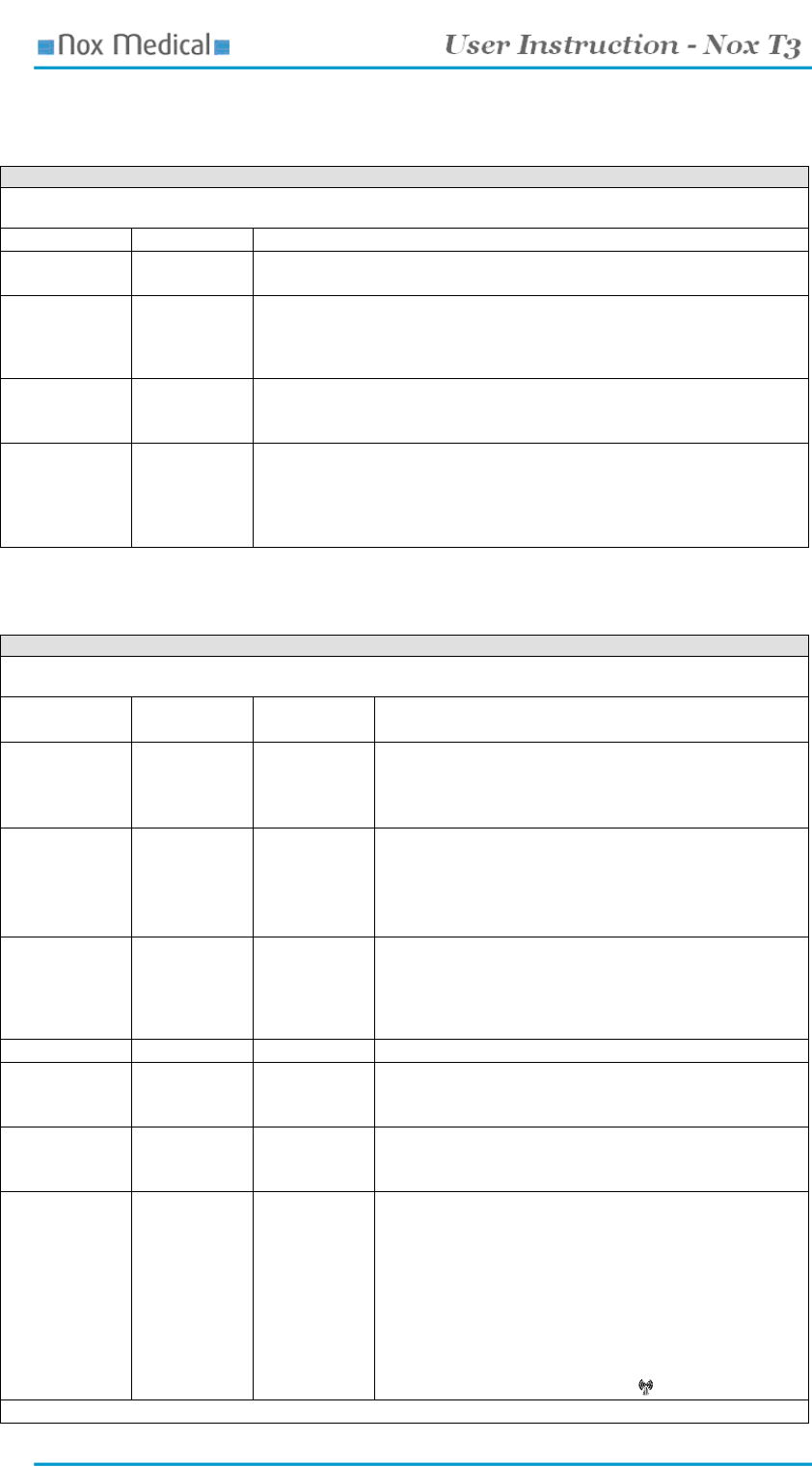
Specification ● 34
Guidance and Manufacturer’s Declaration – Electromagnetic
Emissions
Guidance and manufacturer’s declaration – electromagnetic emissions
The Nox T3 system is intended for use in the electromagnetic environment specified below. The customer or the
user of the device should assure that it is used in such an environment.
Emissions test Compliance Electromagnetic environment – guidance
RF emissions
CISPR 11
Group 2 The Nox T3 device must emit electromagnetic energy in order to perform its
intended function. Nearby electronic equipment may be affected.
RF emissions
CISPR 11
Class B The Nox T3 system is suitable for use in all establishments, including
domestic establishments and those directly connected to the public low-
voltage power supply network that supplies buildings used for domestic
purposes.
Harmonic
emissions
IEC 61000-3-2
N/A
Voltage
fluctuations/
flicker
emissions
IEC 61000-3-3
N/A
Guidance and Manufacturer’s Declaration – Electromagnetic
Immunity
Guidance and manufacturer’s declaration – electromagnetic immunity
The Nox T3 device is intended for use in the electromagnetic environment specified below. The customer or the
user of the system should assure that it is used in such an environment.
Immunity test IEC 60601
test level
Compliance
level Electromagnetic environment – guidance
Electrostatic
discharge
(ESD)
IEC 61000-4-2
±6kV contact
±8kV air
±6kV contact
±8kV air
Floors should be wood, concrete or ceramic tile. If floors
are covered with synthetic material, the relative humidity
should be at least 30%.
Power
frequency
(50/60Hz)
magnetic field
IEC 61000-4-8
3A/m 3A/m Power frequency magnetic fields should be at levels
characteristic of a typical location in a typical commercial
or hospital environment.
Portable and mobile RF communications equipment should
be used no closer to any part of Nox T3 device, including
cables, than the recommended separation distance
calculated from the equation applicable to the frequency of
the transmitter.
Recommended separation distance
Conducted RF
IEC 61000-4-6
3V
rms
150kHz to
80MHz
3V
rms
d = 1.2√P
Radiated RF
IEC 61000-4-3
3 V/m
80MHz to
2.5GHz
3V/m d = 1.2√P 80MHz to 800MHz
d = 2.3√P 800MHz to 2.5GHz
where P is the maximum output power rating of the
transmitter in watts (W) according to the transmitter
manufacturer and d is the recommended separation
distance in meters (m).
Field strengths from fixed RF transmitters, as determined
by an electromagnetic site survey,
a
should be less than the
compliance level in each frequency range.
b
Interference may occur in the vicinity of equipment
marked with the following symbol:
NOTE 1: At 80MHz and 800MHz, the higher frequency range applies.
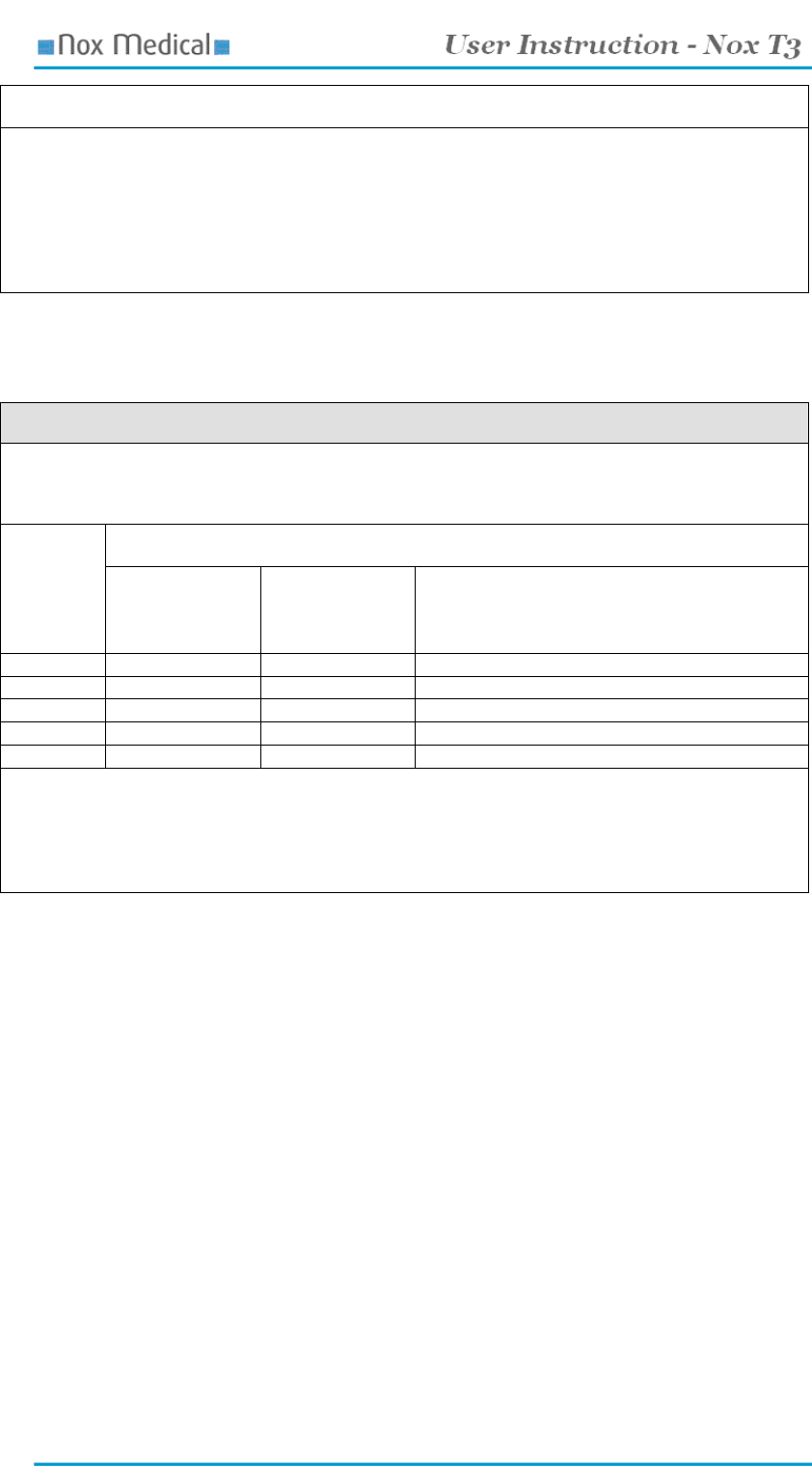
Specification ● 35
NOTE 2: These guidelines may not apply in all situations. Electromagnetic propagation is affected by absorption
and reflection from structures, objects and people.
a
Field strengths from fixed transmitters, such as base stations for radio (cellular/cordless) telephones and land
mobile radios, amateur radio, AM and FM radio broadcast and TV broadcast cannot be predicted theoretically
with accuracy. To assess the electromagnetic environment due to fixed RF transmitters, an electromagnetic site
survey should be considered. If the measured field strength in the location in which the Nox T3 device is used
exceeds the applicable RF compliance level above, the Nox T3 device should be observed to verify normal
operation. If abnormal performance is observed, additional measures may be necessary, such as reorienting or
relocating the Nox T3 device.
b
Over the frequency range 150kHz to 80MHz, field strengths should be less than 3V/m.
Recommended Separation Distance between Portable and Mobile
RF Communications Equipment and the Nox T3 Device
Recommended separation distance between portable and mobile RF communications equipment and the
Nox T3 device
The Nox T3 device is intended for use in an electromagnetic environment in which radiated RF disturbances are
controlled. The customer or the user of the system can help prevent electromagnetic interference by maintaining
a minimum distance between portable and mobile RF communications equipment (transmitters) and the Nox T3
device as recommended below, according to the maximum output power of the communications equipment.
Rated
maximum
output
power of
transmitter
W
Separation distance according to frequency of transmitter
m
150kHz to
80MHz
d = 1.2√P
80MHz to
800MHz
d = 1.2√P
800MHz to 2.5GHz
d = 2.3√P
0.01 0.12 0.12 0.23
0.1 0.38 0.38 0.73
1 1.2 1.2 2.3
10 3.8 3.8 7.3
100 12 12 23
For transmitters rated at a maximum output power not listed above, the recommended separation distance d in
meters (m) can be estimated using the equation applicable to the frequency of the transmitter, where P is the
maximum output power rating of the transmitter in watts (W) according to the transmitter manufacturer.
NOTE 1 At 80MHz and 800MHz, the separation distance for the higher frequency range applies.
NOTE 2 These guidelines may not apply in all situations. Electromagnetic propagation is affected by absorption
and reflection from structures, objects and people.